#also my way of saying go support the director’s new movie Queer :}
Explore tagged Tumblr posts
Text
mak reminds me challengers exist and I am perhaps…. Fixated
#➤ ʀᴀɴᴋ ᴛɪᴇʀ ᴘɪss 4. / ooc.#OH MY GOD#thinking about the churro scene… the oral fixation…..#ezreal would spit the gum into his homo homies hands let it Be Known.#Such a good movie#also my way of saying go support the director’s new movie Queer :}
6 notes
·
View notes
Text
Karan Soni and Jonathan Groff are well-known for their blockbusters – but their latest project, the critically acclaimed indie A Nice Indian Boy, marks a welcome gear change.
The guys discussed their new film, currently rated 100% Fresh on Rotten Tomatoes, with Attitude alongside director Roshan Sethi at last night’s BFI London Film Festival screening at the Curzon Mayfair.
Asked to sum up the film’s plot, Karan said: “My character meets Jonathan’s character, we fall in love, and then I have to introduce him to my very traditional Indian family. He has to win them over before the wedding.”
Added Jonathan: “I just watched the movie for the first time a couple of days ago; I wanted to see it in a theatre, not a link on my laptop. And I was so overwhelmed by the power of this movie.”
“I’ve been saying the movie is for everyone – for queer people, for not queer people, for Indian people, not Indian people,” Roshan meanwhile told us.
Sharing feedback he’s received from parents at screening Q&As, Karan said: “They spoke about their own journey, with not going to their children’s weddings. They’ve come to peace with it years later, but they’ve missed chunks of their lives with their children. A lot of them spoke about, if they had a version of this movie earlier, maybe would have bridged that gap sooner.”
Jonathan, of course, is known for his work in the two Frozen films and 2021’s The Matrix Resurrections, plus popular TV shows like Glee and Looking. The Tony Award-winner is also a stage veteran, with credits including Hamilton and Merrily We Roll Along.
“That would be amazing if that happened,” said Jonathan of the possibility of fans of his studio films supporting this title. “That, in some ways, is out of our control. But in my gut, I feel like great work and great art finds its way. I believed in this script and this team. … Happily, if there are people who are Glee or Frozen or Mindhunter or musical theatre fans, I’m so happy to bring them this story. But I think the movie is powerful enough to bring people on its own accord.”
Describing the plot of the film, Roshan said: “We shot a dance sequence that appears somewhere in the movie. It was tremendously difficult, but very memorable!” And asked for standout feedback to the film, he said: “Probably from my mother, who said she understood me in a way she hadn’t before! It was very sweet, very moving.”
Reflecting on the importance of film criticism, Roshan said: “It’s the most important thing. This is my second independent film, and third overall. In each case, independent films in particular, … survive on the critics’ response. That’s what gets the attention of distributors, who are all reading every single review and looking at the Rotten Tomatoes score. It [makes it] easier to make the next movie as well. It makes a huge, huge difference. Also, people at the distributors often don’t believe there’s an audience for a movie. Critics often prove that there is.”
30 notes
·
View notes
Text
Troy Quane and Nick Bruno on queer representation and mental health in Nimona
I attended a Q and A with Troy Quane and Nick Bruno, the directors of Nimona, four days ago. I tried to transcribe as much as I could but most of this is paraphrased
Obviously Nimona is filled with messages about queerness and mental health but the movie wasn't always explicitly about that. When they first came onto the project, they looked at the comic and said "Ok, it's a story about acceptance. That's easy." But they quickly found themselves getting stumped. They tried a few different plot lines, but none were really landing the way they wanted them to. So, they went back to the comic and asked themselves, "What about this resonated with audiences?" The main thing they found was the queer themes and they decided to lean into it.
The problem was that they had no idea how to do that so they started talking with people. They opened up the conversation to everyone on the production team, not just the story department, as well as lgbt support groups, their families, and even building facility workers. Once the conversation got started, Nick Bruno said it was amazing; "There were people I had worked with for sixteen years suddenly coming out because they felt comfortable doing so." As more people voiced their experiences Quane and Bruno realized that this story was going to be incredibly important to a lot of people.
That's part of the reason why they pushed hard for this movie to be made. They said that they finished a bunch of demo reels at Blue Sky and were going to show them to the team on Thursday. Disney shut down Blue Sky that Tuesday. They showed the reels anyway over zoom and said it was a very tearful meeting. A lot of the people whose voices and experiences had gone into it had to find jobs on new projects. They said they were calling as many industry friends as possible and pitching the reels to everyone they could because they felt it was too important a story to abandon. They knew how many personal experiences and feelings were already engrained in the story and how detrimental it would be, both to the story and their coworkers, if they let it die. They didn't want to lose the voices of "the people they loved" just because Disney said so.
They elaborated on this saying that the reason why Disney wanted to change it so much was that they felt it "was too specific a story to appeal to a wide audience." Troy Quane said that he actually found it was the opposite. The more they focused in on being othered because of queerness, the more they were able to explore being othered because of race, class, neurodivergence, disability, and a million other things. Because they got so specific, they were able to relate the story to everyone.
Troy Quane also said that he wasn't expecting the reaction they got to the movie. He shared a story about a screening they did in Toronto. He said, "Afterwards we were all kinda hanging out in the lobby and I saw a man hanging around in the back. He looked like he wanted to say something but was kind of nervous about it, so I waved him over. He said, 'Thank you for making this movie. The entire third act with Nimona...' And then he just broke down in my arms. I stood there for about five minutes hugging this stranger. It was astounding. ...I still haven't processed it." To lighten the mood, Nick Bruno joked, "I haven't had anyone hug me!" Quane responded with "I was just hugging you backstage!"
part one part two
#i had to include that joke they said at the end bc i thought it was very sweet and funny#nimona#nimona netflix#nimona movie#nimona 2023
46 notes
·
View notes
Text
'Andrew Scott cut a dapper figure as he attend the National Theatre Live screening of his play Vanya at The May Fair Hotel in London on Tuesday.
The actor, 47, wore a long brown coat with large lapels over a white vest top.
He wore a pair of trousers to match the coat and opted for a pair of smart black shoes.
The star was seen posing with designer and co-creator Rosanna Vize who wore a black leather jacket and trousers in the same colour for the occasion.
He was also seen smiling as he posed alongside director and co-creator Sam Yates who wore a black jacket and matching suit trousers.
He completed his look by wearing a white polo shirt which he wore buttoned up at the collar.
Performing in the play, Andrew brings to life multiple characters in adapter and co-creators Simon Stephens' radical new version of Anton Chekhov’s Uncle Vanya.
Comedic and tragic, Anton’s examination of people's shared humanity - hopes, dreams, regrets - is thrust into sharp focus in the production.
This play explores the 'kaleidoscope of human emotions, harnessing the power of the intimate bond between actor and audience to delve deeper into the human psyche'.
It comes after Andrew said being an openly gay man in the modern age is a 'wonderful gift' that has helped him establish firm friendships within the queer community.
He told Attitude: 'I think it's such a wonderful thing to me. It's an extraordinary gift to my life and just to be able to see the real beauty in being gay is completely wonderful.
'The older I get, just the more I feel so lucky to have been born gay and that pervades my life in the sense of all my friendships.
'I have so many amazing queer friends in my life now that I just adore.'
He added: 'I feel such a huge sense of camaraderie with other queer people now, and without sounding too hippy about it, I feel like I just want to spread that love and positivity in our community because we've come such a long way and it's important that we are kind and look out for each other, and celebrate how uniquely different and how f**king wonderful that can be.'
Meanwhile, Andrew and Paul Mescal dmitted they weren't too keen on their family members watching their new film All Of Us Strangers.
The movie stars Andrew as a screenwriter who enters into a relationship with a mysterious neighbour, played by Paul, 27.
It features several intimate scenes between the actors which the pair discussed during an appearance on The Graham Norton Show.
Asked if their families had seen the flick, Paul said: 'With the Irish premiere, trying to allocate tickets to all the aunties and uncles is a tricky business.
'They have seen my bum before but there is a little more going on in this movie I would say!'
Andrew added: 'I don't want to be there when my parents watch it!'
All Of Us Strangers dominated the competition at the British Independent Film Awards, earning a staggering seven gongs in total.
Among the awards was the top prize for Best Film, beating Femme, How To Have Sex, Rye Lane and Scrapper.
All Of Us Strangers also scored Best Director and Best Screenplay for Andrew Haigh, who is known for his work on films Weekend and 45 Years.
Paul shared the Best Supporting Performance gong for his role in the film with Shaun Thomas from How To Have Sex.'
#Andrew Scott#Paul Mescal#British Independent Film Awards#Vanya#National Theatre Live#Uncle Vanya#Sam Yates#Rosanna Vize#Simon Stephens#Anton Chekhov#The Graham Norton Show#Andrew Haigh#Weekend#45 Years
3 notes
·
View notes
Text
some more movies I watched this year (so far) that had some things to say about queerness that made my head explode
the transexual menace (1996): rosa von praunheim just wandered around new york interviewing trans people in a way that is off the walls in terms of just how many voices are included in the piece. the community, the scale of it, it's like rapid fire "how many experiences can you include in this (yes)." if you want to be inundated with the feeling of "we have always been here and we've always been fucking cool." my favourite ongoing thread is the interviews of trans immigrants from several continents, but there's so much to take in in such a short runtime, I feel like it deserves 100 more watches
kokomo city (2023): d smith celebrating black trans sex workers in several cities in america, notably allowed the kind of freedom of expression that comes from being an intracommunity piece, rather than voyeuristic a la elements of paris is burning. I swear our greatest philosophers of the age are black trans sex workers, you do not hear these truths in mainstream LGBT politics and philosophy, and also it's so fucking funny. d smith herself was lamenting how often film doesn't show just how funny trans women can be, as a part of undermining the overall complexity of trans woman experiences
wildhood (2021): a story about a multi-ethnic kid who flees his abusive father and goes on a roadtrip to find his mother and reconnect with his native Mi'kmaw heritage, and on the way also allows himself to challenge the fraught masculinity he was raised on, via falling in love with an Anishinabeg boy *deep breath.* there's no way I can celebrate this harder than through the above description, it packs so much depth of suppressed identities into a simple story, I don't think its like exists honestly, and that's not even going into how compellingly acted the characters are
honey moccasin (1998): so at the beginning of the year there was a one month online festival celebrating native film and I went on a binge -- this movie I went into without knowing the plot and I kind of loved that experience, so I'm hesitant to say too much about plot (also because how to summarise a plot so cornucopian). in terms of feel though, this is something that offers a tantalising example of counter-image to dominant, hollywood-ised cinema, not quite "avant-garde" so much as simply wholly itself, a joyful ride through a place and time, incredibly funny, and with that complex gender-sexuality-ethnicity that isn't easy to sum up using white eurocentric terminology
glen or glenda (1953): I don't think it's quite possible to be able to fully comprehend how modern trans identities have been crafted without this film. at this point in time american psychiatrists were winning the fight to "own" the language of transness, putting us squarely (or so they thought) into the realm of pathologisation and medicalisation as a way of enforcing conformity. this film captures that zeitgeist, while also putting out impassioned pleas for tolerance, in language that is struggling against the small box that we can exist in, at times breaking out and giving us images that are intensely modern (or maybe reminiscent of pre-war ideas?) and at others functioning within those limitations. it's frustrating, it's illuminating, it's colonialist, it's an attempt at liberation, it's an indelible, visible stamp of history
lotus sports club: this one's a tad more personal to me, I've screened this movie, I've met one of the directors, I play football, getting to see trans people a continent away building spaces that I've found lacking in my own country (but crucially are being built at a community level now as well) squeezes at my heart so intensely, both times I've seen this film I've felt like I wasn't breathing. we're connected across space in a way that cannot be sufficiently described in a simple summary. also there's a fundraiser to support this team and the trans guys who've played on it so there's a tangible way to reach out to our siblings in Cambodia
great freedom 🤝 joyland
queer existence may be treated as unwanted and even criminal, but it’s potentially full of far more freedom and community and joy than can be found by clinging desperately to systems that make you force yourself into tinier versions of selfhood, just to maintain correct ways of being, and although there is likely punishment and loss and pain that these smaller people will dole out to force queerness out of existence, the fight is worth it, and the self is worth it, and the joy is worth it
#queer cinema#trans cinema#kokomo city#glen or glenda#honey moccasin#wildhood#transexual menace#great freedom#joyland#2023 went: let me hit you over the head with THE most movies of all time#me going through my movies on letterboxd am reminded just how in love i have fallen with shelley niro -- she deserves all the budget#some movies i want to watch this year that i think will have similar Effects: t blockers - sedimentos - querelle - rodeo - mutt - ponyboi#- the advocate for fagdom - khejdi - I remember the crows - the wound - l'animale - southern comfort#gosh probably many others. also this is just this year#i have so many favourite queer movies#also some that are favourite without rewiring my brain
140 notes
·
View notes
Link
“Elliot Page doesn’t remember exactly how long he had been asking.
But he does remember the acute feeling of triumph when, around age 9, he was finally allowed to cut his hair short. “I felt like a boy,” Page says. “I wanted to be a boy. I would ask my mom if I could be someday.” Growing up in Halifax, Nova Scotia, Page visualized himself as a boy in imaginary games, freed from the discomfort of how other people saw him: as a girl. After the haircut, strangers finally started perceiving him the way he saw himself, and it felt both right and exciting.
The joy was short-lived. Months later, Page got his first break, landing a part as a daughter in a Canadian mining family in the TV movie Pit Pony. He wore a wig for the film, and when Pit Pony became a TV show, he grew his hair out again. “I became a professional actor at the age of 10,” Page says. And pursuing that passion came with a difficult compromise. “Of course I had to look a certain way.”
We are speaking in late February. It is the first interview Page, 34, has given since disclosing in December that he is transgender, in a heartfelt letter posted to Instagram, and he is crying before I have even uttered a question. “Sorry, I’m going to be emotional, but that’s cool, right?” he says, smiling through his tears.
It’s hard for him to talk about the days that led up to that disclosure. When I ask how he was feeling, he looks away, his neck exposed by a new short haircut. After a pause, he presses his hand to his heart and closes his eyes. “This feeling of true excitement and deep gratitude to have made it to this point in my life,” he says, “mixed with a lot of fear and anxiety.”
It’s not hard to understand why a trans person would be dealing with conflicting feelings in this moment. Increased social acceptance has led to more young people describing themselves as trans—1.8% of Gen Z compared with 0.2% of boomers, according to a recent Gallup poll—yet this has fueled conservatives who are stoking fears about a “transgender craze.” President Joe Biden has restored the right of transgender military members to serve openly, and in Hollywood, trans people have never had more meaningful time onscreen. Meanwhile, J.K. Rowling is leveraging her cultural capital to oppose transgender equality in the name of feminism, and lawmakers are arguing in the halls of Congress over the validity of gender identities. “Sex has become a political football in the culture wars,” says Chase Strangio, deputy director for transgender justice at the ACLU.

(Full article with photos continued under the “read more”)
And so Page—who charmed America as a precocious pregnant teenager in Juno, constructed dreamscapes in Inception and now stars in Netflix’s hit superhero show The Umbrella Academy, the third season of which he’s filming in Toronto—expected that his news would be met with both applause and vitriol. “What I was anticipating was a lot of support and love and a massive amount of hatred and transphobia,” says Page. “That’s essentially what happened.” What he did not anticipate was just how big this story would be. Page’s announcement, which made him one of the most famous out trans people in the world, started trending on Twitter in more than 20 countries. He gained more than 400,000 new followers on Instagram on that day alone. Thousands of articles were published. Likes and shares reached the millions. Right-wing podcasters readied their rhetoric about “women in men’s locker rooms.” Casting directors reached out to Page’s manager saying it would be an honor to cast Page in their next big movie.
So, it was a lot. Over the course of two conversations, Page will say that understanding himself in all the specifics remains a work in progress. Fathoming one’s gender, an identity innate and performed, personal and social, fixed and evolving, is complicated enough without being under a spotlight that never seems to turn off. But having arrived at a critical juncture, Page feels a deep sense of responsibility to share his truth. “Extremely influential people are spreading these myths and damaging rhetoric—every day you’re seeing our existence debated,” Page says. “Transgender people are so very real.”
That role in Pit Pony led to other productions and eventually, when Page was 16, to a film called Mouth to Mouth. Playing a young anarchist, Page had a chance to cut his hair again. This time, he shaved it off completely. The kids at his high school teased him, but in photos he has posted from that time on social media he looks at ease. Page’s head was still shaved when he mailed in an audition tape for the 2005 thriller Hard Candy. The people in charge of casting asked him to audition again in a wig. Soon, the hair was back.
Page’s tour de force performance in Hard Candy led, two years later, to Juno, a low-budget indie film that brought Page Oscar, BAFTA and Golden Globe nominations and sudden megafame. The actor, then 21, struggled with the stresses of that ascension. The endless primping, red carpets and magazine spreads were all agonizing reminders of the disconnect between how the world saw Page and who he knew himself to be. “I just never recognized myself,” Page says. “For a long time I could not even look at a photo of myself.” It was difficult to watch the movies too, especially ones in which he played more feminine roles.
Page loved making movies, but he also felt alienated by Hollywood and its standards. Alia Shawkat, a close friend and co-star in 2009’s Whip It,describes all the attention from Juno as scarring. “He had a really hard time with the press and expectations,” Shawkat says. “‘Put this on! And look this way! And this is sexy!’”
By the time he appeared in blockbusters like X-Men: The Last Stand and Inception, Page was suffering from depression, anxiety and panic attacks. He didn’t know, he says, “how to explain to people that even though [I was] an actor, just putting on a T-shirt cut for a woman would make me so unwell.” Shawkat recalls Page’s struggles with clothes. “I’d be like, ‘Hey, look at all these nice outfits you’re getting,’ and he would say, ‘It’s not me. It feels like a costume,’” she says. Page tried to convince himself that he was fine, that someone who was fortunate enough to have made it shouldn’t have complaints. But he felt exhausted by the work required to “just exist,” and thought more than once about quitting acting.
In 2014, Page came out as gay, despite feeling for years that “being out was impossible” given his career. (Gender identity and sexual orientation are, of course, distinct, but one queer identity can coexist with another.) In an emotional speech at a Human Rights Campaign conference, Page talked about being part of an industry “that places crushing standards” on actors and viewers alike. “There are pervasive stereotypes about masculinity and femininity that define how we’re all supposed to act, dress and speak,” Page went on. “And they serve no one.”
The actor started wearing suits on the red carpet. He found love, marrying choreographer Emma Portner in 2018. He asserted more agency in his career, producing his own films with LGBTQ leads like Freeheld and My Days of Mercy. And he made a masculine wardrobe a condition of taking roles. Yet the daily discord was becoming unbearable. “The difference in how I felt before coming out as gay to after was massive,” says Page. “But did the discomfort in my body ever go away? No, no, no, no.”
In part, it was the isolation forced by the pandemic that brought to a head Page’s wrestling with gender. (Page and Portner separated last summer, and the two divorced in early 2021. “We’ve remained close friends,” Page says.) “I had a lot of time on my own to really focus on things that I think, in so many ways, unconsciously, I was avoiding,” he says. He was inspired by trailblazing trans icons like Janet Mock and Laverne Cox, who found success in Hollywood while living authentically. Trans writers helped him understand his feelings; Page saw himself reflected in P. Carl’s memoir Becoming a Man. Eventually “shame and discomfort” gave way to revelation. “I was finally able to embrace being transgender,” Page says, “and letting myself fully become who I am.”
This led to a series of decisions. One was asking the world to call him by a different name, Elliot, which he says he’s always liked. Page has a tattoo that says E.P. PHONE HOME, a reference to a movie about a young boy with that name. “I loved E.T. when I was a kid and always wanted to look like the boys in the movies, right?” he says. The other decision was to use different pronouns—for the record, both he/him and they/them are fine. (When I ask if he has a preference on pronouns for the purposes of this story, Page says, “He/him is great.”)
A day before we first speak, Page will talk to his mom about this interview and she will tell him, “I’m just so proud of my son.” He grows emotional relating this and tries to explain that his mom, the daughter of a minister, who was born in the 1950s, was always trying to do what she thought was best for her child, even if that meant encouraging young Page to act like a girl. “She wants me to be who I am and supports me fully,” Page says. “It is a testament to how people really change.”
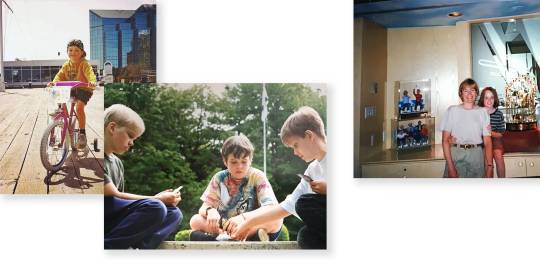
Another decision was to get top surgery. Page volunteers this information early in our conversation; at the time he posted his disclosure on Instagram, he was recovering in Toronto. Like many trans people, Page emphasizes being trans isn’t all about surgery. For some people, it’s unnecessary. For others, it’s unaffordable. For the wider world, the media’s focus on it has sensationalized transgender bodies, inviting invasive and inappropriate questions. But Page describes surgery as something that, for him, has made it possible to finally recognize himself when he looks in the mirror, providing catharsis he’s been waiting for since the “total hell” of puberty. “It has completely transformed my life,” he says. So much of his energy was spent on being uncomfortable in his body, he says. Now he has that energy back.
For the transgender community at large, visibility does not automatically lead to acceptance. Around the globe, transgender people deal disproportionately with violence and discrimination. Anti-trans hate crimes are on the rise in the U.K. along with increasingly transphobic rhetoric in newspapers and tabloids. In the U.S., in addition to the perennial challenges trans people face with issues like poverty and homelessness, a flurry of bills in state legislatures would make it a crime to provide transition-related medical care to trans youth. And crass old jokes are still in circulation. When Biden lifted the ban on open service for transgender troops, Saturday Night Live’s Michael Che did a bit on Weekend Update about the policy being called “don’t ask, don’t tuck.”
Page says coming out as trans was “selfish” on one level: “It’s for me. I want to live and be who I am.” But he also felt a moral imperative to do so, given the times. Human identity is complicated and mysterious, but politics insists on fitting everything into boxes. In today’s culture wars, simplistic beliefs about gender—e.g., chromosomes = destiny—are so widespread and so deep-seated that many people who hold those beliefs don’t feel compelled to consider whether they might be incomplete or prejudiced. On Feb. 24, after a passionate debate on legislation that would ban discrimination against LGBTQ people, Representative Marie Newman, an Illinois Democrat, proudly displayed the pride flag in support of her daughter, who is trans. Representative Marjorie Taylor Greene, a Georgia Republican, responded by hanging a poster outside her office that read: There are TWO genders: MALE & FEMALE.
The next day Dr. Rachel Levine, who stands to become the first openly transgender federal official confirmed by the Senate, endured a tirade from Senator Rand Paul about “genital mutilation” during her confirmation hearing. My second conversation with Page happens shortly after this. He brings it up almost immediately, and seems both heartbroken and determined. He wants to emphasize that top surgery, for him, was “not only life-changing but lifesaving.” He implores people to educate themselves about trans lives, to learn how crucial medical care can be, to understand that lack of access to it is one of the many reasons that an estimated 41% of transgender people have attempted suicide, according to one survey.
Page has been in the political trenches for a while, having leaned into progressive activism after coming out as queer in 2014. For two seasons, he and best friend Ian Daniel filmed Gaycation, a Viceland series that explored LGBTQ culture around the world and, at one point, showed Page grilling Senator Ted Cruz at the Iowa State Fair about discrimination against queer people. In 2019, Page made a documentary called There’s Something in the Water, which explores environmental hardships experienced by communities of color in Nova Scotia, with $350,000 of his own money. That activism extends to his own industry: in 2017, he published a Facebook post that, among other things, accused director Brett Ratner of forcibly outing him as gay on the set of an X-Men movie. (A representative for Ratner did not respond to a request for comment.)
As a trans person who is white, wealthy and famous, Page has a unique kind of privilege, and with it an opportunity to advocate for those with less. According to the U.S. Trans Survey, a large-scale report from 2015, transgender people of color are more likely to experience unemployment, harassment by police and refusals of medical care. Nearly half of all Black respondents reported being denied equal treatment, verbally harassed and/or physically attacked in the past year. Trans people as a group fare much worse on such stats than the general population. “My privilege has allowed me to have resources to get through and to be where I am today,” Page says, “and of course I want to use that privilege and platform to help in the ways I can.”
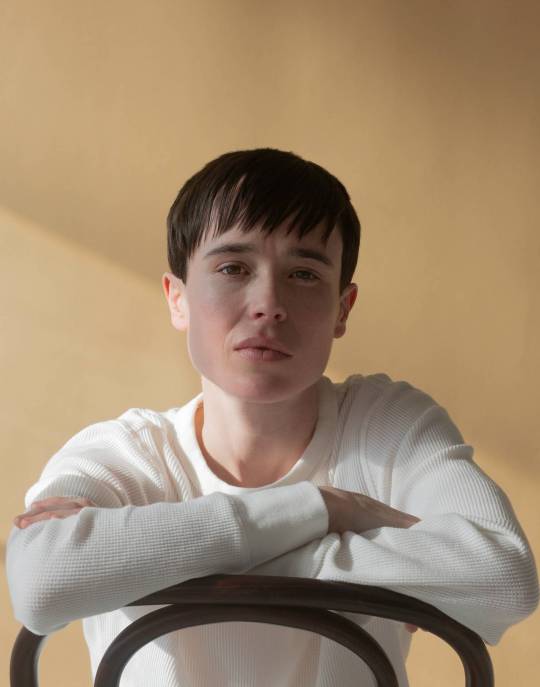
Since his disclosure, Page has been mostly quiet on social media. One exception has been to tweet on behalf of the ACLU, which is in the midst of fighting anti-trans bills and laws around the country, including those that ban transgender girls and women from participating in sports. Mississippi Governor Tate Reeves says he will sign such a bill in the name of “protect[ing] young girls.” Page played competitive soccer and vividly recalls the agony of being told he would have to play on the girls’ team once he aged out of mixed-gender squads. After an appeal, Page was allowed to play with the boys for an additional year. Today, several bills list genitalia as a requirement for deciding who plays on which team. “I would have been in that position as a kid,” Page says. “It’s horrific.”
All this advocacy is unlikely to make life easier. “You can’t enter into certain spaces as a public trans person,” says the ACLU’s Strangio, “without being prepared to spend some percentage of your life being threatened and harassed.” Yet, while he seems overwhelmed at times, Page is also eager. Many of the political attacks on trans people—whether it is a mandate that bathroom use be determined by birth sex, a blanket ban on medical interventions for trans kids or the suggestion that trans men are simply wayward women beguiled by male privilege—carry the same subtext: that trans people are mistaken about who they are. “We know who we are,” Page says. “People cling to these firm ideas [about gender] because it makes people feel safe. But if we could just celebrate all the wonderful complexities of people, the world would be such a better place.”
Even if Page weren’t vocal, his public presence would communicate something powerful. That is in part because of what Paisley Currah, a professor of political science at Brooklyn College, calls “visibility gaps.” Historically, trans women have been more visible, in culture and in Hollywood, than trans men. There are many explanations: Our culture is obsessed with femininity. Men’s bodies are less policed and scrutinized. Patriarchal people tend to get more emotional about who is considered to be in the same category as their daughters. “And a lot of trans men don’t stand out as trans,” says Currah, who is a trans man himself. “I think we’ve taken up less of the public’s attention because masculinity is sort of the norm.”
During our interviews, Page will repeatedly refer to himself as a “transgender guy.” He also calls himself nonbinary and queer, but for him, transmasculinity is at the center of the conversation right now. “It’s a complicated journey,” he says, “and an ongoing process.”
While the visibility gap means that trans men have been spared some of the hate endured by trans women, it has also meant that people like Page have had fewer models. “There were no examples,” Page says of growing up in Halifax in the 1990s. There are many queer people who have felt “that how they feel deep inside isn’t a real thing because they never saw it reflected back to them,” says Tiq Milan, an activist, author and transgender man. Page offers a reflection: “They can see that and say, ‘You know what, that’s who I am too,’” Milan says. When there aren’t examples, he says, “people make monsters of us.”
For decades, that was something Hollywood did. As detailed in the 2020 Netflix documentary Disclosure, transgender people have been portrayed onscreen as villainous and deceitful, tragic subplots or the butt of jokes. In a sign of just how far the industry has come—spurred on by productions like Pose and trailblazers like Mock—Netflix offered to change the credits on The Umbrella Academy the same day that its star posted his statement on social media. Now when an episode ends, the first words viewers see are “Elliot Page.”
Today, there are many out trans and nonbinary actors, directors and producers. Storylines involving trans people are more common, more respectful. Sometimes that aspect of identity is even incidental, rather than the crux of a morality tale. And yet Hollywood can still seem a frightening place for LGBTQ people to come out. “It’s an industry that says, ‘Don’t do that,’” says director Silas Howard, who got his break on Amazon’s show Transparent, which made efforts to hire transgender crew members. “I wouldn’t have been hired if they didn’t have a trans initiative,” Howard says. “I’m always aware of that.”
So what will it mean for Page’s career? While Page has appeared in many projects, he also faced challenges landing female leads because he didn’t fit Hollywood’s narrow mold. Since Page’s Instagram post, his team is seeing more activity than they have in years. Many of the offers coming in���to direct, to produce, to act—are trans-related, but there are also some “dude roles.”
Downtime in quarantine helped Page accept his gender identity. “I was finally able to embrace being transgender,” he says.
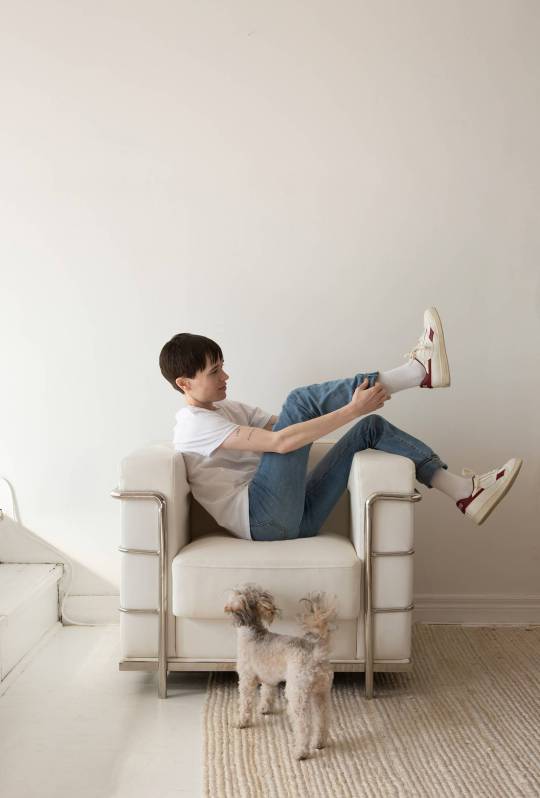
Page was attracted to the role of Vanya in The Umbrella Academy because—in the first season, released in 2019—Vanya is crushed by self-loathing, believing herself to be the only ordinary sibling in an extraordinary family. The character can barely summon the courage to move through the world. “I related to how much Vanya was closed off,” Page says. Now on set filming the third season, co-workers have seen a change in the actor. “It seems like there’s a tremendous weight off his shoulders, a feeling of comfort,” says showrunner Steve Blackman. “There’s a lightness, a lot more smiling.” For Page, returning to set has been validating, if awkward at times. Yes, people accidentally use the wrong pronouns—“It’s going to be an adjustment,” Page says—but co-workers also see and acknowledge him.
The debate over whether cisgender people, who have repeatedly collected awards for playing trans characters, should continue to do so has largely been settled. However, trans actors have rarely been considered for cisgender parts. Whatever challenges might lie ahead, Page seems exuberant about playing a new spectrum of roles. “I’m really excited to act, now that I’m fully who I am, in this body,” Page says. “No matter the challenges and difficult moments of this, nothing amounts to getting to feel how I feel now.”
This includes having short hair again. During our interview, Page keeps rearranging strands on his forehead. It took a long time for him to return to the barber’s chair and ask to cut it short, but he got there. And how did that haircut feel?
Page tears up again, then smiles. “I just could not have enjoyed it more,” he says.”
#suicide m#transphobia m#Elliot Page#transgender#representation#celebrities#actors#tv#movies#rep#trans#transmasculine#nonbinary#queer#long post
2K notes
·
View notes
Text
The Best Yuri of 2020
2020 was hell in every way, and many of us are looking forward to new possibilities and advances in 2021. However, the year brought us many small moments and gifts worth celebrating. Among these, the explosive growth and change within the Yuri genre are among the most precious and most outstanding achievements. This second century of Yuri opened with a bang, as phenomenal new works, creators, and moments made their mark and helped change the future genre.

This annual list is a celebration of just a handful of the fantastic titles, people, and events in Yuri. There are likely some even greater ones that did not make the list because there is so much content in both English and Japanese that even I cannot keep up. However, among the troves of treasure, these titles stood out as shining examples of Yuri excellence. Some were released this year, others were recently adapted into English, and still, others are established titles that rose to prominence to dominate the conversation and my mind this year, but every one of them is worthy of being on this list and in your heart.
Here is the Best Yuri of 2020!
15: The Curse of Kudan Remastered
Japanese Yuri visual novel developers show no sign of slowing down as they continue to push to new heights and try new ideas. These are the same amazing people who brought us the delightful educational Yuri game The Expression Amrilato and the hilarious and surprisingly queer OshiRabu: Waifus Over Husbando’s. However, this most recent release, The Curse of Kudan Remastered, is their best work yet. Released near Halloween, this game brings a new edge of dark mystery and the occult to Yuri audiences worldwide.
The Curse of Kudan is available on MangaGamer, JAST USA, Denpasoft, and Sekai Project.
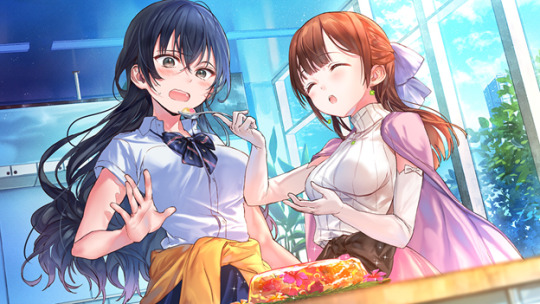
14: Adachi and Shimamura
English audiences were finally treated this year to Hitoma Iruma’s long-running and wildly successful Yuri light novel series, Adachi and Shimamura. Although the story struggles to gain traction, dedicated readers’ have their patience rewarded with a sweet tale full of gay pining. Alternatively, you can jump into its stellar anime adaptation, with gorgeous visuals and realized characters you will actually be willing to put up with the annoying Yashiro just to see where the title characters go. The series shows no sign of slowing down either, as the manga adaptation is coming to Western audiences next year.
Adachi and Shimamura is available to stream on Funimation. The light novel series is published by Seven Seas - https://amzn.to/3rTSZTK

Honorable Mention: Happy Go Lucky Days
The OVA adaptation of Fragtime got most of the attention this year. Still, director Takuya Satou and Pony Canyon also gave us this much-overlooked “love is love” anthology movie based on Takako Shimura’s manga (Sweet Blue Flowers, Wandering Son). The first short in the film, “Happy,” is easily the best Yuri anime of the year. It follows the beautiful yet realistic queer love story of two women hooking up at a mutual ex-girlfriend’s wedding, only for the relationship to blossom and warm viewers’ hearts. Sadly, while stylized, the budget demanded the animation cut a few too many corners. Additionally, the subsequent stories are at best tedious and at worst alarmingly problematic, which is why Happy Go Lucky Days only gets an honorable mention.
The OVA is streaming on HIDIVE

13: Mieri Hiranishi
The Yuri scene has many colorful creators with a breadth of different ideas and stories in the genre, yet few have provided as much humor and joy as Mieri. This talented creator spectacularly tumbled into the scene with her manga essay The Moment I Realized I Wasn’t Straight, which embodies the brutal honesty and realism of Nagata Kabi and matches it with exaggerated hilarity. She continues to chronicle her painful struggles of being a butch girl in love with butch girls in the monthly series The Girl that Can’t Get a Girlfriend. Alternatively, you can follow her on Twitter for just as much heart and laughter.
Read The Girl that Can’t get a Girlfriend on Tapas and Webtoon.
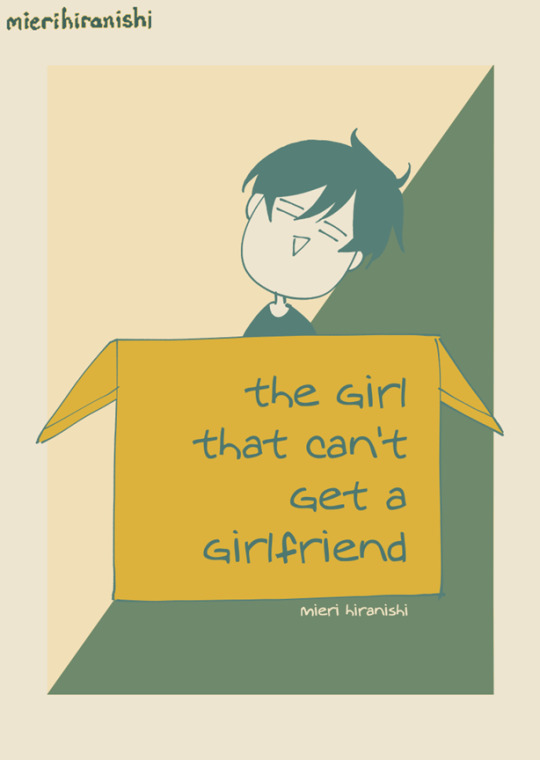
12: My Next Life as a Villainess: All Routes Lead to Doom!
My Next Life as a Villainess has what can only be described as volcanic bisexual energy. Every character protagonist Catarina Claes encounters is entirely enthralled by her. Of course, she is far too preoccupied with her quest to avoid doom flags and change her ultimate fate to notice any romantic interest. The series is rewarding and well structured, as views are just as focused on how Catarina plans to avoid certain doom as they are with the various romantic misses her band of companions cooks up. While the “friendship ending” did not capitalize on its Yuri potential, it was perhaps the most satisfying possibility for this crazy harem, at least until season two comes out, which looks, unfortunately, to be significantly less queer.
My Next Life as a Villainess is streaming on Crunchyroll
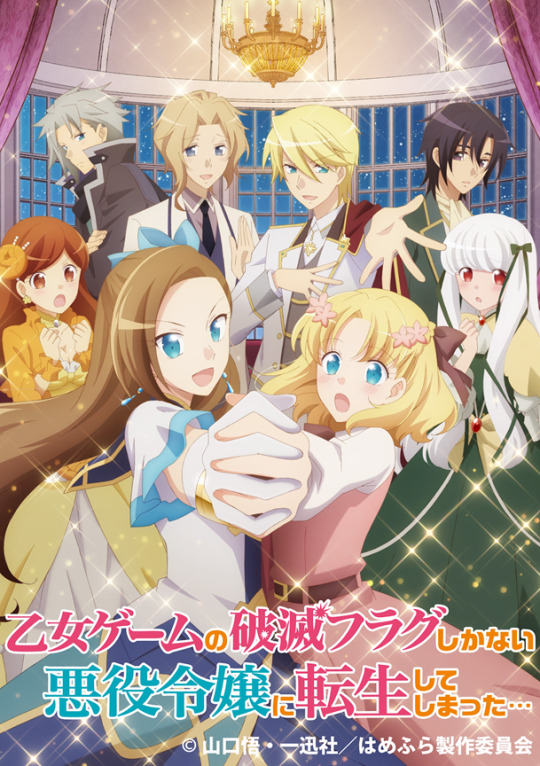
11: Love Me for Who I Am
Kata Konayama’s manga series is less Yuri than a general LGBT work, but it has a lesbian character and explores her identity and struggles in great detail. Few titles before have captured the exciting and nervous waves of emotions that young people feel as they explore gender and sexual identities and try to find themselves. This heartfelt and extremely queer series rubberbands between cute moe dress up to tragic and gripping backstory, keeping readers on their toes the whole time.
Love me for Who I Am is published by Seven Seas - https://amzn.to/3rTSZTK
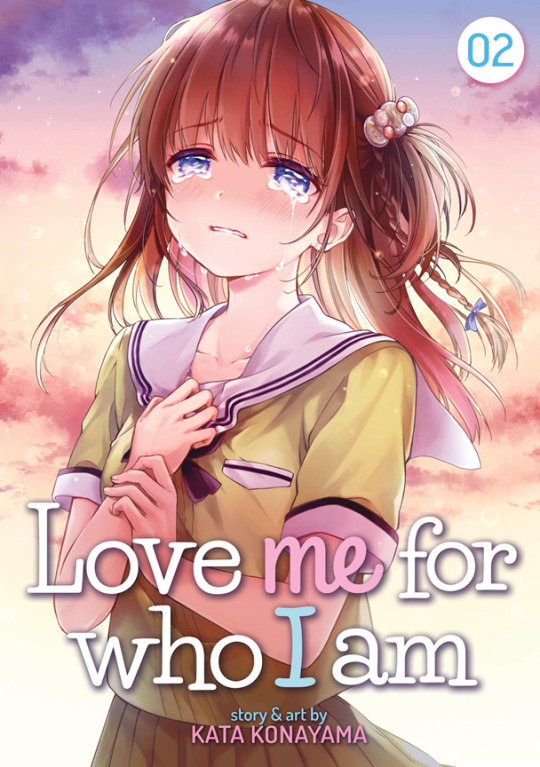
10: A Summer’s End – Hong Kong 1986
Oracle and Bone’s debut visual novel, A Summer’s End, is set in a vibrant and electric 1980’s Hong Kong. Drawing inspiration from classic Asian cinema, music, and fashion. The worlds of Michelle, a young office worker, and a free-spirited woman named Same collide. The two struggle to comprehend and accept each other’s feelings just as they struggle against society’s expectations and prejudices. An incredibly thoughtful and touching adventure, the creators incorporated vital contemporary elements include Asian LGBTQ rights and growing political unrest in Hong Kong, into this illustrious game.
The visual novel is available on Steam.
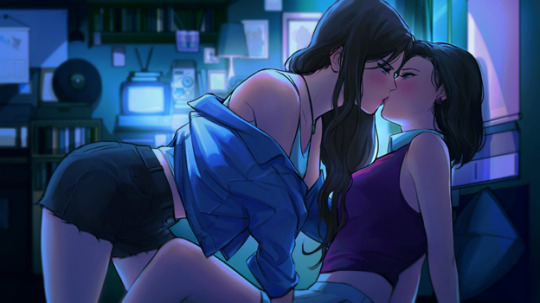
Honorable Mention: Goodbye, My Rose Garden
In the same vein as A Summer’s End, Goodbye, My Rose Garden is a beautiful period piece that incorporates LGBT views into its shattering narrative. The story follows a bright-eyed immigrant, Hanako, wanting to make a new life in England as an author at the dawn of the twentieth century. She takes a job as a maid to noblewoman Alice, but their relationship takes a turn when Alice asks Hanako to kill her. This poignant tale is beautiful and an honest depiction of love and its conflict with responsibility and society.
Goodbye, My Rose Garden is published by Seven Seas Entertainment - https://amzn.to/3hFSyaG
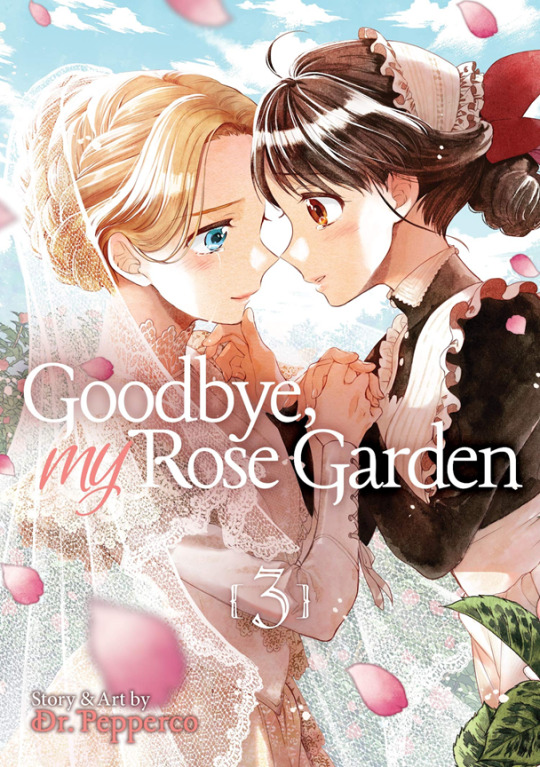
9: Shio Usui
Usui’s hit Shaikaijin Yuri manga Doughnuts Under a Crescent Moon could easily take this spot even though it is not even out in English until February 2021. The manga is already making waves and receiving constant praise. The characters and their journey to discover love and self-acceptance are as charming as they are relatable and grounded. However, it is the creator, Usui, who really deserves acclaim. Not just for their work on Doughnuts, but having a second serialized story, Onna Tomodachi to Kekkon Shitemita, in monthly Yuri magazine Comic Yuri Hime simultaneously. It is even more remarkable when you consider these two iconic stories are Usui’s first long-running works, as they only contributed one-shots before.
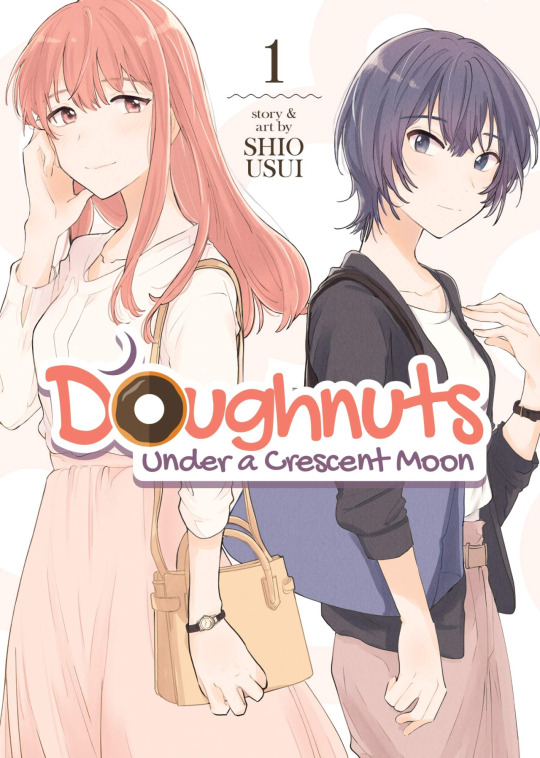
8: Bloom Into You: Regarding Saeki Sayaka
Bloom Into You is possibly the most iconic Yuri series in the past decade, and while the manga deserves its own place on this list, the best thing to come out of the series as a whole is easily the light novels. This trilogy by Adachi and Shimamura creator Hitoma Iruma dives deep into supporting cast member Sayaka. Readers are treated to a delightful journey as she discovers her sexuality, experiences heartbreak, and finally finds herself breaking free and falling in love. With the help of gorgeous illustrations by Nakatani Nio herself, Iruma masterfully captures Sayaka’s unique voice and emotions in this wonderful series. Whether a fan of the originals or not, every Yurijin must check out Regarding Saeki Sayaka.
The light novel series is published by Seven Seas - https://amzn.to/3hFSyaG
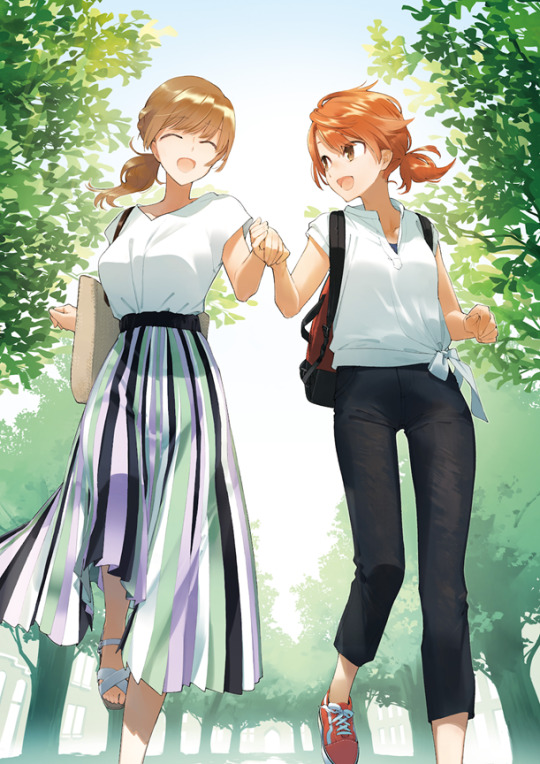
7: Our Teachers are Dating
The best a Yuri can get. This workplace romance follows two teachers at the start of a new relationship taking nervous yet enthusiastic first steps, including saying I love you, going on their first date, and even sleeping together. It is so heartfelt and salacious that readers will squeal the whole time. Additionally, our heroines are supported in their relationship by everyone they know, their students, colleagues, and even the principal. It is a perfect world for these two lovebirds! Our Teachers are Dating would easily be number one or two in any other year, but the competition is fierce in 2020. So even though this is only number seven, it is still a master class Yuri manga.
The manga is published by Seven Seas Entertainment - https://amzn.to/38XY3O9
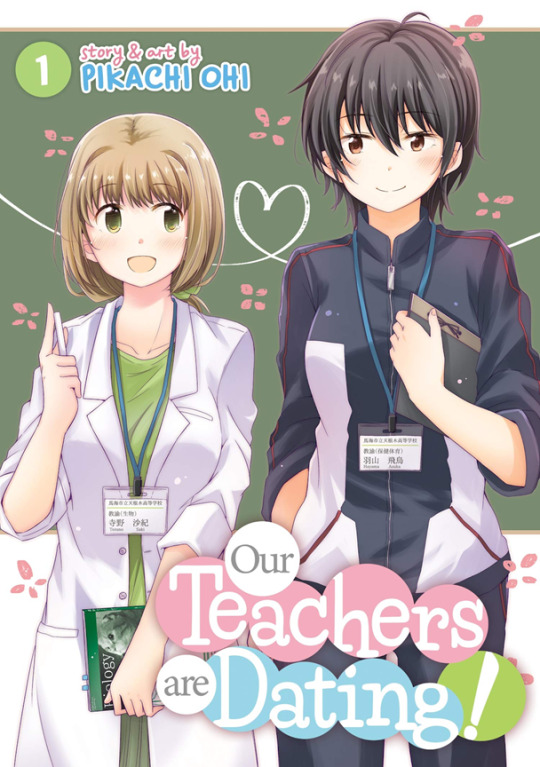
6: Amongst Us
Who would have thought that a comedy alternative universe story spinoff of a fantasy action series would be the single best Yuri webcomic this year? Shilin’s astounding artwork illustrations the hilarious and irresistible journey of girlfriends Blackbird and Veloce. These two eccentric young women get into all kinds of everyday mischief that bounces between tender and touching romance, completely outrageous comedy, and downright thirst-inducing sorcery. Seriously, you should buy the first volume for Veloce’s back muscles alone. The storyline skips between time, but both their established relationship and their meeting as teenagers are adorkable and captivating.
Amongst Us is available online free on Webtoon and the comic’s website. The first volume is in paperback on Shilin’s site.
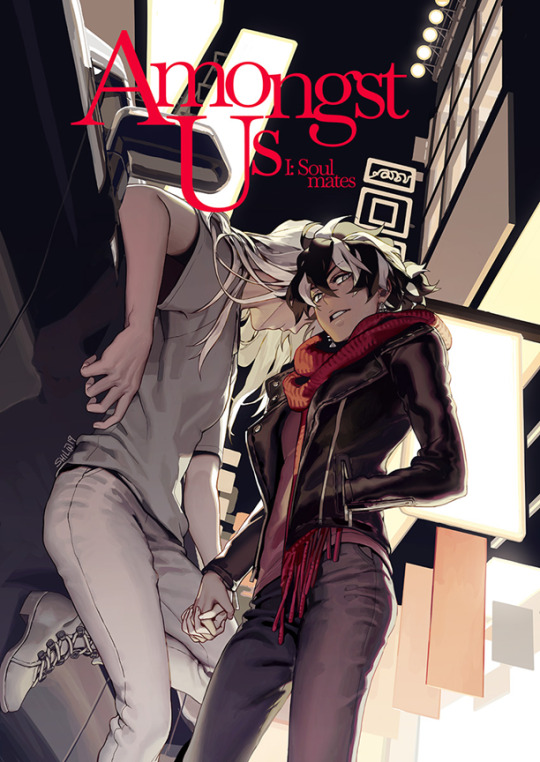
Honorable Mention: Éclair
There are a lot of Yuri anthologies out there, and they have done some beautiful things. Many focus on themes like Syrup. Others collect a series of stories by an author into one bound work. However, out of all of them, Éclair is the most successful. ASCII Media Works took some of the genre’s most extraordinary creators and let them do whatever they wanted, and the results are spectacular. The incredible talent behind Éclair somehow packs a full volume’s worth of story and character into just a few pages with every chapter. While the first volume came overseas a few years ago, Yen Press gave Yurijin a gift this year by releasing the entire rest of the series in which readers can get lost.
The anthology series is published by Yen Press - https://amzn.to/38XY3O9
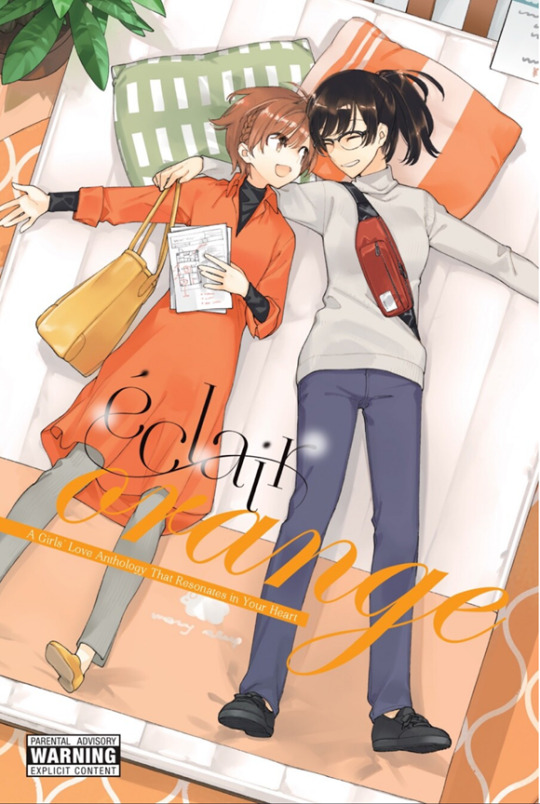
5: I’m in Love with the Villainess
A small trend of isekai Yuri with villainesses emerged recently, and I honestly had few hopes of I’m in Love with the Villainess. The series is pretty popular, but I often find that this does not denote quality, and with isekai having some institutional issues, I suspected this would fall flat. Then the volume three cover showcased an incredible accomplishment, allowing for a lesbian relationship to blossom into a family with children, and it blew me away. Finally, I read volume one and realized that the series has incredible character, some of the best world-building I have ever seen in a light novel, thoughtful discussions of inequality and societal issues, and most impressively, open and frank discussion of queer identity and life Yuri has ever seen! This one is something special.
The series is published by Seven Seas Entertainment - https://amzn.to/3nedvdZ
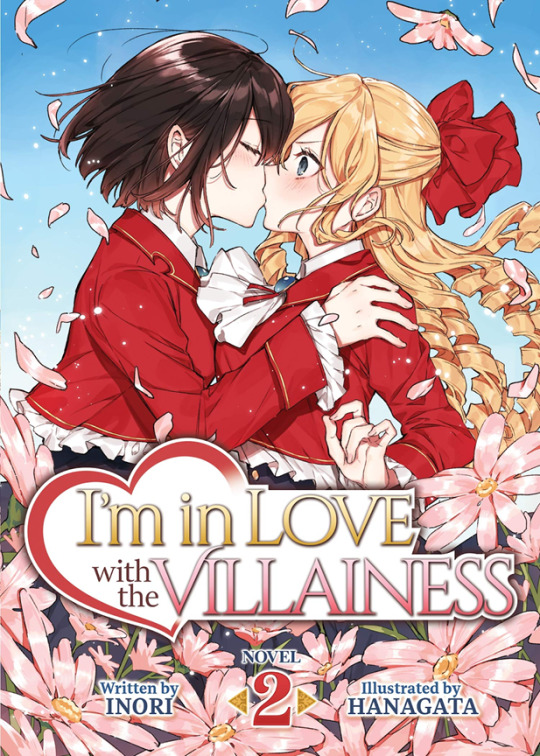
4: The Last of Us Part II
Yes, I know this one is not Yuri and that a portion of the population despises this game and will likely be exceptionally angry at me for including it. However, I maintain that it was an incredibly challenging masterpiece. Naughty Dog did not take the easy route out and delivered one of the most devastating media experiences I have ever seen. As I said in my article about the game, playing it changed me, and it sticks with me to this day. The Last of Us Part II earns its spot on this list because it pushed boundaries more with LGBTQ inclusion than any other AAA game. From brave inclusion of LGBTQ themes to queer characters and storylines at its center, the game changes gaming and it will never go back.
The Last of Us Part II is available on PlayStation 4
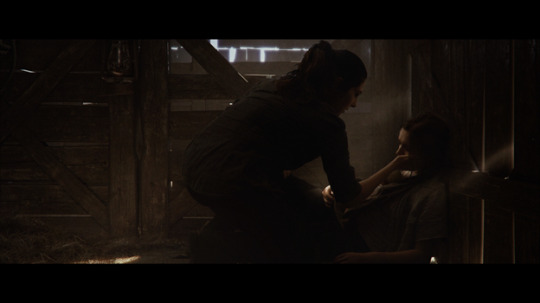
3: She-Ra and the Princesses of Power
She-Ra feels like the culmination of all the LGBTQ progress western cartoons have made over the past few years. From The Legend of Korra to Steven Universe, young people are finally seeing more LGBTQ people represented on the small screen. This epic fantasy concluded with an amazing and powerful lesbian romance, delivering on its queer promise and revolutionized representation in a trope-defying crescendo.
She-Ra and the Princesses of Power is streaming on Netflix
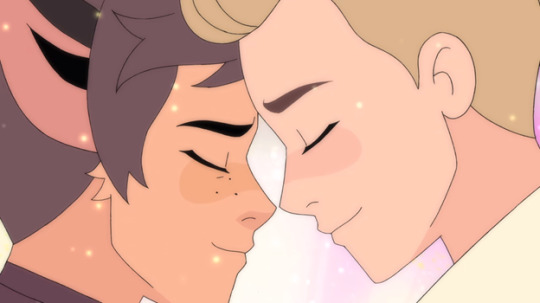
2: The Conditions of Paradise
The greatest single Yuri work of all in 2020 was the English release of Akiko Morishima’s breakthrough manga, The Conditions of Paradise. Initially released in 2007, this anthology detailed the love between adult women. It was in every way a manga ahead of its time, and seeing it finally get a small piece of the recognition it deserves overseas is a true gift. The fact that we can own this legendary piece of Yuri history and Morishima’s other anthologies is nothing short of a blessing from the Yuri goddess.
The Conditions of Paradise is published by Seven Seas Entertainment - https://amzn.to/38bh4xq
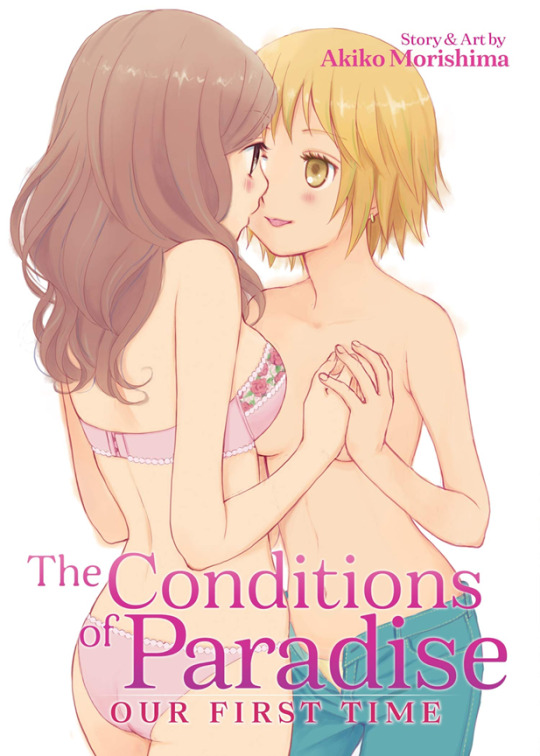
Honorable Mention: Otherside Picnic
This eerie sci-fi horror series combines the best of pulse-pounding thrillers, complex and intelligent hard science fiction, and exciting Yuri romance. Author Iori Miyazawa spends as much time crafting a well-paced and intriguing narrative about a mysterious world where occult creatures roam as he does establishing two believable and grounded heroes in Sorawo and Toriko. The romance between the two may be slow to start, but their chemistry is undeniable and as the stakes and story build, so too does their relationship. Not only are the light novels incredible, but the series’ manga adaptation is coming soon to the West as well as an upcoming TV anime in early 2021.
Otherside Picnic is streaming on Funimation. The light novels are published by J-Novel Club - https://amzn.to/3niiv1g
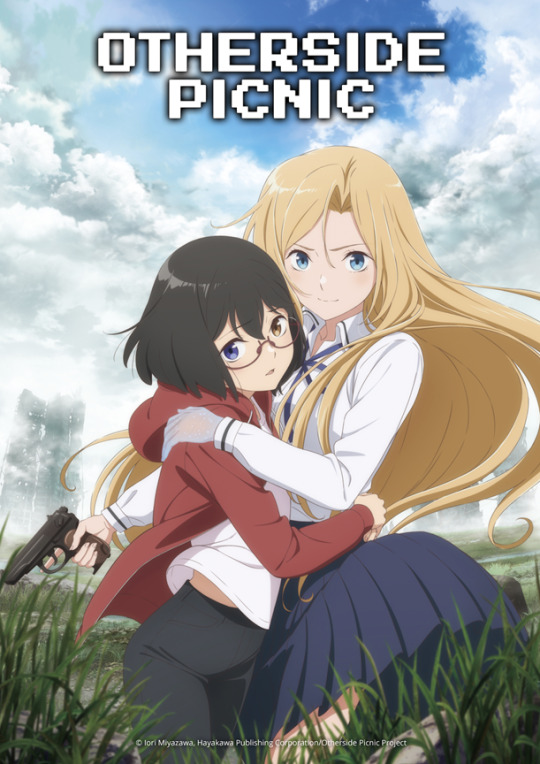
1. Yuri subgenres
For a long time, Yuri was not a genre of its own, but elements of romances or bonds between women found in other works. Now, thanks to an increasing library of works, the advent of social media, and a wider audience, Yuri is a genre on its own, with many creators telling different stories in different styles. However, 2020 saw the continued emergence of something extraordinary, subgenres. Yuri is now so vast, we can actually categorize the works within. Depending on their characters, like classic schoolgirl romances or spicy shakaijin office affairs, their world, such as fantasy or isekai series and thrilling science fiction adventures, and even other elements within. One of my personal favorites is the feminist Yuri that emerges from titles like Sexiled, where women celebrate the accomplishments of other women and dismantle power structures stacked against them. Now, no matter what kind of Yurijin you are, there is something for you to love.
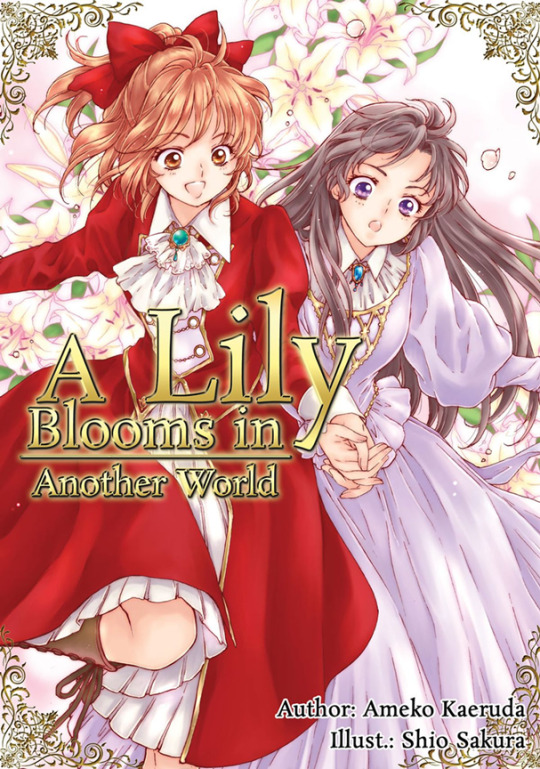
I am happy to leave 2020 behind, but I bring with me a renewed love and admiration for Yuri. 2021 looks to be a somehow even better year for the genre, and I am thrilled to experience every minute of it that I can. Yuri has transformed into something far greater than I ever thought it would be, and let us all enjoy its evolution and expansion together in 2021.
#yuri#manga#anime#top 10#lgbt#lgbtq#lgbtq+#queer#gay#girls love#gl#adachi and shimamura#otherside picnic#lists#2020#happy new year#2021#new year
2K notes
·
View notes
Note
obviously the point of BL is relationships but I was wondering if you had any recs for BLs which have particularly strong found family vibes that go beyond the main pairing?
BLs With Strong Found Family Vibes!
This ask turned out to be a lot harder than I thought it would. Technically speaking, the narrative journey of a found family means that the main character should start out relatively isolated (a loner) and then either pull together a friendship group or get absorbed by a ready-made one.
Most BL actually gives their characters pretty solid friendship groups to start with. Director Cheewin has been a big fan of this since his Make It Right days and still doing it, see SCOY. These narratives will often end with group trips to the beach and lots of imagery of a friends frolicking together. But while they contain found family (queer friendship groups) that’s not part of the journey of the story.
Found family narratives require a larger cast. Which makes me think we would probably would get more from places like Korea and Taiwan, if they ever budgeted for large cast BLs. Semantic Error, for example, could have done this with J’s little designer cadre absorbing S into it’s artistic fold. And I think it’s implied that this happens after they start dating but not depicted.
So this is a long way of saying that in the end, I had to look for shorter threads and representations of found family, rather than narratives that were built entirely on this trope.
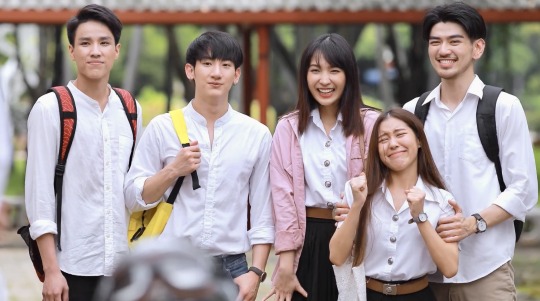
Found Family In BL
(Below I’ve I picked photos of the ones I think qualify the most)
Takumi-kun - believe it or not, could make the case that it qualifies
Love Next Door 2 - it’s hot and ultra early Thai not-yet-BL but it’s also not good but he sorta gets adopted by the fab weirdos at the cafe.
Grey Rainbow - but also DON’T WATCH IT
We Are Gamily - not really BL
YYY - it’s absurd nonsensical camp, but there I guess?
My Dear Loser: Edge of 17 - is about found family and a makeover but the BL is a sub-plot
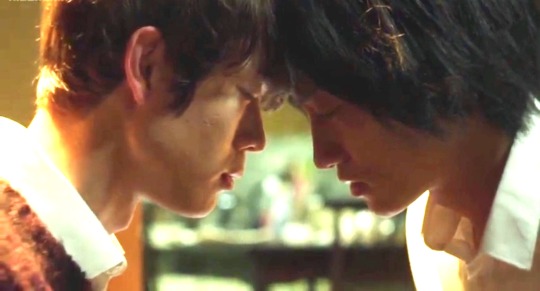
His the movie - again it’s not a main driver but it is important to the plot that the whole village support them
HIStory 3 the BL that shall not be named - the seme’s friendship group eventually adopts the uke
Friend Forever - actually really could have leaned into this but they don’t execute well
Maybe Gameboys? I mean it’s a small group but he does get one by the end

My Day - it’s actual blood family but Sky’s amazing loving fam absolutely systematically sets out to adopt Ace, it’s an adorable campaign, similarly the chefs adopt Sky
Wish You - I think it qualifies, but it is Korea and stiff about it
Evening Cafe - not good, my memory could be flawed
Love Area - again, they try, and it would have been better if they had focused on the restaurant fam (I’m sensing a theme)
Top Secret Together - should have gone there with the Gay Advice Dads’ cafe but didn’t quite manage

Kieta Hatsukoi AKA My Love Mix Up - this one basically yes, I mean the scene where they all get protective over Aoki having to face up to his teacher’s homophobia, be still my heart! CLASSIC found family friendship group. SO GOOD.
Word of Honor - I mean then they kill all the found family at the end, but that’s Chinese censored BL for ya
Given - another one that had the foundation (band romance) but not the bandwidth (PUN! See what I did there?)
Be Loved In House I Do - they try but the new boss is very resistant, was is ultimately successful, like Semantic Error I think we can assume yes but it’s not depicted

Love is Science? - BL side couple result = ACTUAL family
Golden Blood - actually I think this one works as found family (for Sun) or at least it tries
My Sweet Dear - again the kitchen should really be used for this, but all too often they don’t get there
The Tasty Florida - almost made it, see above, probubly qualifies the most of its ilk
To My Star - another one that was *just* there but we never really say it happen in the end
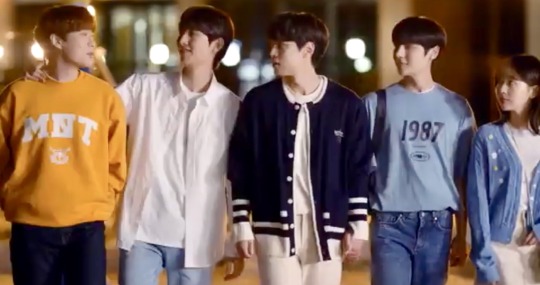
Light on Me - you know what, I think this qualifies, I mean T sets out specifically to find friends, so he’s intentionally trying to build himself fam, and he does
Tinted With You - it’s a tiny family but I think it is one, and again the ending make’s it clear
Not Me - sure, why not?
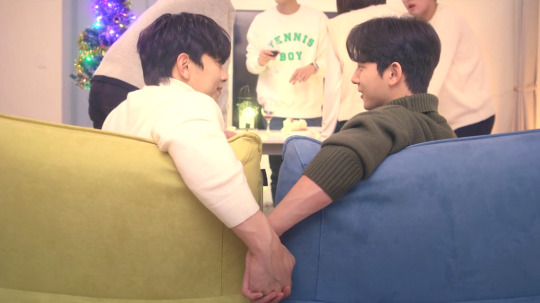
Oh! Boarding House - I think this one is definitely found family (by forced proximity) but the ending makes it clear
CURRENTLY AIRING
What’s Zabb Man - dabbled with this in the kitchen
KinnPorsche - it’s set up to be, I mean literally the bodyguards all living together and stuff
Honestly what I’ve learned from this list is Thai & Korean BL should capitalize on their wave of restaurant set BL to activate found family narratives more intentionally. IMHO
But also I think, outside of Japan and het Kdramas, Asian countries don’t often do found family because pre-existing family/friends groups are so very very important and so often a part of the narrative already.
This trope requires a starting situation where one of the characters (preferably the main one) is already a loner and isolated, and even the most tsundere characters in BL usually have friends who put up with them. I mean, think about Dean in UWMA. Talk about a character who should, by rights, have no friends. And yet there’s Win, putting up with him. Or Lian and Yi in Cutie Pie, they have each other. I mean Japan, of course, does isolated emo-boy all the time, but Japan would prefer a creepy weirdo (affectionate) just finds himself another weirdo so they can mutually obsess over each other...
Isolated loaners looking to be saved by the warmth of a group are actually pretty rare archetypes in BL. Huh. Interesting.
(source)
#thai bl#korean bl#japanese bl#Cutie Pie#Until We Meet Again#kbl#k-bl#taiwanese BL#KinnPorsche#What’s Zabb Man#Oh! Boarding House#not me the series#Tinted With You#Light on Me#To My Star#The Tasty Florida#My Sweet Dear#Golden Blood#Love is Science?#Be Loved In House I Do#Given live action#Word of Honor#Kieta Hatsukoi#My Love Mix Up#Top Secret Together#Love Area the series#Evening Cafe#Wish You: Your Melody From My Heart#My Day the series#pinoy bl
30 notes
·
View notes
Text
With news that mads Mikkelsen has not perfect politics I would like to implore Tumblr white queer people to ask why you thought he would have good politics.
Yes he has played queer people but he also has a habit of playing Eastern Europeans almost exclusively as villains in Western English speaking movies
Look at the directors he has worked with. he has never worked for a man of color and only one woman of color and that was Rihanna on a co-directing credit for her music video. He is then worked with one white woman his repertoire continuously shows that he almost exclusively works with cis white men
So what he affirms fanfiction and ships what you ship so what? he's a wealthy Danish man in a country that still profits from its colonialism and hides its ugly history with the slave trade and he has never once spoken about their violently anti immigrant policies
The reason he hasn't said anything cancelable is because every single one of his interviews are incredibly softballed designed to almost avoid any discussion of politics (y'all should have suspicious of that)
The One English interview that actually put him sort of in the hot seat reveals that he doesn't care which is very much in line with the politics of Danish complacency. Is this time to ask yourself why are you surprised. With all the political unrest with all the political things going on he has not said a single thing what does that tell you.
Oh he's so quirky and weird and says funny things literally interact with any middle-aged Dane they're all like that ( by the way my Danish in-laws are also quirky and weird but they have better politics and are nice (i love you Charlotte))
Stop being surprised that passive support of queerness means anything other than a paycheck
#mads mikkelsen#mads as grindelwald#denmark#j k rowling#transmysogyny#racism#hannibal lecter#Hannibal
8 notes
·
View notes
Text
The Great White Gripe
A lot has been said about the “social commentary” within The Falcon and the Winter Soldier.
“Since when is Marvel a bunch of SJWs? I don’t need this shit.”
“All this race stuff feels SUPER forced.”
“Oh here we go Marvel tryin to be all woke to get the libs on board.”
If you personally know anyone who spews this brand of ignorance, we’re sorry.
Let’s make one thing perfectly clear: there is no social commentary on TFATWS. Showrunner Malcolm Spellman and director Kari Skogland simply show the reality of life in America. It’s not their fault that so many (white) people (men) don’t like looking in the mirror.
And some people claim they have no problem with film and television addressing politics and social change.
“Just keep it out of my comic book movies. It doesn’t belong there.”
They could not be anymore wrong, even if Chandler Bing himself was lecturing them.
If you asked 100 people to name the top ten movies of all time, you’d get 100 different lists. But one thing we can all agree on is that film has power. It has the power to move us, to divide us, to unite us. Entertainment can lead to the kind of discourse that prompts action and positive change.
And that’s why The Falcon and the Winter Soldier and the conversations it’s sparking are so important.
One World, One Reality
“Marvel has always been and always will be a reflection of the world right outside our window.” - Stan Lee
There are two takeaways from that statement:
One: Stan Lee didn’t say that in the 1960s, 1970s, or even the 1980s. He said it in 2017.
Two: Our window, not your window, is a subtle but important distinction, particularly as it relates to TFATWS. The Flag Smashers, led by Karli Morgenthau, live by a simple creed: “One world, One people.” The core message of the show is that white Americans and Black Americans experience the world very differently, but there’s still only one world, one reality.
It’s just a matter of people opening their eyes and seeing it.

TFATWS is an extension of Marvel’s early support of the Civil Rights Movement. In 1963, Stan Lee created the X-Men as an allegory for the ongoing struggles of the African-American community. Though he didn’t explicitly base Professor X and Magneto on Martin Luther King, Jr. and Malcolm X, there are ideological similarities.
Five years later, following the assassinations of Dr. King and Robert Kennedy, Stan wrote the following:
“Bigotry and racism are among the deadliest social ills plaguing the world today. It’s totally irrational, patently insane to condemn an entire race—to despise an entire nation—to vilify an entire religion. Sooner or later, we must learn to judge each other on our own merits. Sooner or later, if a man is ever to be worthy of his destiny, we must fill our hearts with tolerance.”
In 2021, Stan’s words still resonate. Racism in the United States is as virulent and damaging as it’s ever been. Black Americans are facing deadly policing, Jim Crow 2.0 voting laws, mass incarceration, and countless other roadblocks to mobility that most white people have never encountered.
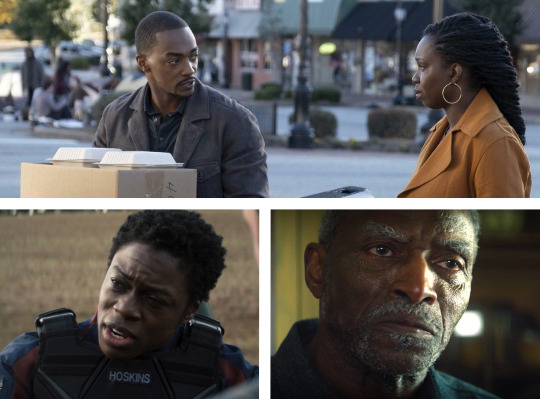
Through the journeys of Sam and Sarah Wilson, Lemar Hoskins, and the heartbreaking Isaiah Bradley, TFATWS shows the unvarnished truth of what Ira Glass might call Black American Life. And through John Walker, the writers nail home the message that’s really making certain people squirm:
White men are the greatest threat not just to Black Americans, but all Americans, because TFATWS is as much an indictment of toxic masculinity as it is of bigotry.
As aggressive racism has spread like wildfire since 2016, so has hostile sexism towards women of all colors. John Walker is the embodiment of the hyper aggression that the Proud Boys applaud. The clearest example of this comes when Walker dares to clap the shoulder of Ayo, one of Wakanda’s Dora Milaje.
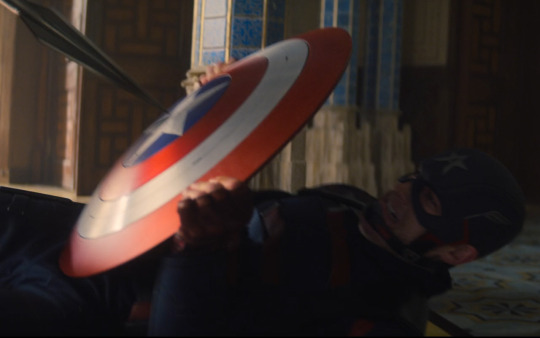
Her swift and, ahem, pointed response had women the world over screaming like they’d just won the lottery.
One could also argue that Walker’s dogged pursuit of Karli and displaced peoples supporting the Flag Smasher cause mirrors the Trump administration’s war on immigrants.
There are plenty of parallels to draw. The point is, none of them are forced or manufactured or exaggerated. And whether we’re talking about a fictional road in Latvia or a real street in Minnesota, white Americans need to stop avoiding conversations that make them uncomfortable.
The Politics of Comics
In 1938, Americans were still reeling from the Great Depression. Enter Superman, the everyman hero, who made his comic debut while the nation was facing widespread unemployment, rampant poverty, and blatant corruption at every level of government.
Superman could have faced off against any number of supernatural villains. But Siegel and Shuster went a different route, setting a precedent for comic books that has prevailed to this day:
They got political.
Throughout Superman’s earliest adventures, he fought against evil politicians, apathetic bureaucrats, aggressive police officers, greedy businessmen, and even a Washington lobbyist.
Then in 1941, Joe Simon & Jack Kirby introduced Captain America just in time to fight the nazis and free the world from fascism. A couple decades later, Kirby and Stan Lee would tell the tale of the aforementioned Erik Lehnsherr, who survived the horrors of Auschwitz. These comics endured because their passion and nuance transcended entertainment. So what was the secret sauce?
Like Siegel and Shuster, Simon, Kirby, and Stan Lee were Jewish. Representation matters, folks.
Later on, the X-Men weren’t the only conduit through which Marvel supported Civil Rights. In 1966, on the heels of the “March Against Fear” from Memphis, TN to Jackson, MS, Stan Lee & Jack Kirby unveiled Black Panther. When African-Americans were fighting harder than ever, Black children could suddenly read a comic book about T’Challa, the noble warrior king of a highly advanced African nation.
Marvel has never been shy about critiquing foreign policy either. Tony Stark and Iron Man debuted in 1968 as the conflict in Vietnam was escalating. And let’s not forget, Tony made his MCU debut in a film that is a clear indictment of the wars in Iraq and Afghanistan.
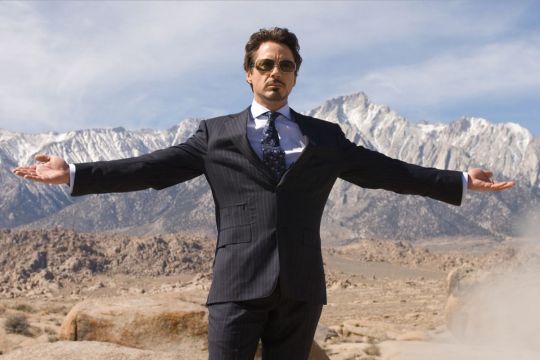
We could do this all day, but you get the idea.
Comic books have always reflected the politics of our times, and so has the MCU. Fanboys can’t start crying now just because they’re on the wrong side of history. And when they do, we defer to the great Jon Bernthal when asked about alt-righters appropriating the Punisher symbol:
“Fuck them.”
Life Imitates Art
In 1986, American men felt the need for speed. After Top Gun was released, applications to U.S. aviation forces increased by a staggering 500%.
Two years later, Errol Morris exposed police corruption in his film The Thin Blue Line. The documentary prompted a new investigation that eventually exonerated death row inmate Randall Adams for the murder of a police officer.
That same year, the Polish government ceased all executions after leaders were swayed to do so by A Short Film about Killing.
Following the release of Michael Moore’s Bowling for Columbine in 1999, Kmart bowed to public pressure and stopped selling handgun ammunition.
And 5 years ago, Pakistani Prime Minister Nawaz Sharif changed the law on honor killings in response to the critically-acclaimed film A Girl in the River.
Like we said earlier, film has the power to spur social change. Even if the effects aren’t always so direct and immediate, television and movies have always contributed to the process in America.

Seeing the Ricardos sharing a bed allowed some Americans to start relaxing their prudish ways.
The Mary Tyler Moore Show and Maude empowered women as they fought for reproductive rights.
The Jeffersons and Good Times facilitated calmer discussions about race relations.
And The Ellen Show led to greater representation of queer people on screen and greater acceptance of queer people in society. Though Ellen herself has become a problematic figure in the last year, that legacy still remains.
The Falcon and the Winter Soldier is hardly the first show of its kind. And given the impact film has on society, we believe Hollywood has a moral obligation to produce content that exposes society’s ills and fosters productive debate.
Stan Lee would be very proud of the team behind TFATWS for bringing the stark reality of American life into people’s living rooms. The next time you see someone bitching about it, remind them what Stan himself said just a few years ago:
“Those stories have room for everyone, regardless of their race, gender, religion, or color of their skin. The only things we don't have room for are hatred, intolerance, and bigotry.”
#marvel#mcu#the falcon and the winter soldier#sam wilson#isaiah bradley#sarah wilson#ayo#wakanda#wakanda forever#dora milaje#stan lee#jack kirby#superman#marvel comics#dc comics#iron man#tony stark#anthony mackie#sebastian stan#social justice#george floyd#justice for george floyd#justice for daunte wright#daunte wright#lgbtq#representation matters#representation#racism#tfatws#flag smashers
115 notes
·
View notes
Text
Who-Dumb-It? – Film Review: Bodies Bodies Bodies ★★1/2

Have you ever wanted to rate a movie using Olympics guidelines? I thought of that while watching Bodies Bodies Bodies from director Halina Reijn. Instead of a detailed review, mustering up all my skills as a film critic, I just wanted to say, Concept: 10, Execution: 2 and leave it at that. Alas, I have a job to do, and I’ll try keep it more interesting than the movie itself.
Taking the familiar slasher trope of gathering a bunch of people in an isolated mansion, adding an oncoming storm and a parlor game gone wrong, and Holy Clue (!), you’ve got yourself a murder mystery. Reijn and a whole team of writers center this familiar story around a group of narcissistic, self-involved, fake smiling Gen-Z types, giving the genre a fresh spin. It also helps that the look and tone of the film in no way resembles its glossy predecessors like Scream. Instead, you wouldn’t be wrong to wonder if you hadn’t wandered into a revival screening of Blue Is The Warmest Colour with its opening handheld image of two young women kissing.
Those women, Sophie (Amandla Stenberg) and Bee (Maria Bakalova) are en route to a Hurricane Party held at her lifelong friend David’s (Pete Davidson) parents’ manor. Fresh out of rehab, Sophie has only recently started dating Bee. Once they arrive, the friends already gathered give them less than a warm welcome. They include the fast-talking podcaster Alice (Rachel Sennott) and her new boyfriend and generational outlier Greg (Lee Pace, who excels as the hunky, mellow vibe bro). Emma (Chase Sui Wonders) uneasily dates David, a misogynistic jerk under his layers of Billie Eilish-style sportswear. Jordan (Myha'la Herrold) has an uneasy history with Sophie and is the first to stir up trouble with the new arrivals.
After a period of bad blood exposed through one micro-aggression after another, the gang decides to play a game of Bodies Bodies Bodies, which, like Mafia, entails one person secretly designated as the killer who, in the dark, taps one person to die, the lights go on and everyone tries to identify the culprit. The game continues as such until the killer gets exposed. It’s all fun and games until someone actually ends up dead, and then another, and then another, etc.
Hats off to the filmmakers for a highly original concept. By centering a story around two queer protagonists and surrounding them with people whose addiction to social media, to presentational wokeness, and to navel gazing taking precedence over such things as physical safety and, oh, survival, the satire rings loud and clear. Clearly intentional, most of the characters exude nastiness and stupidity to the degree that you root for nobody, except for the charming but underused Pace. Sennott, so good in Shiva Baby, knows exactly what movie she’s in, playing her ridiculously chattering character so well, that you know that the only thing that’s gonna shut her up is if someone kills her.
But therein lies the problem. You start to hate everyone and stop caring who lives or dies. We watch them endlessly racing through the house with only their cell phone flashlights to guide them, but none of it seems to matter. I especially hated Sophie when Bee gets exiled outside by the others, in a raging hurricane, and Sophie does absolutely nothing to help her girlfriend. Sophie is a terrible partner, and in the spirit of this film’s nihilistic themes, I sat there hoping that Bee would lop her head off for this terrible transgression. By the way, Bakalova, an Oscar nominee for Borat Subsequent Moviefilm, delivers a terrifically twitchy, unnerving performance here, showing an impressive range while being given little support from the vague screenwriting.
After what felt like 10 hours, this 95 minute film sticks its landing with a very clever twist. It’s almost enough to redeem the entire film, but there are stretches where characters sounded more like talking points instead of real people, such as the line: "Don’t call her a psychopath, that is so ableist” which literally made my eyes roll into the back of my head, killing whatever wasn’t already dead inside me. I know it’s all in keeping with the point they’re trying to make, but even in a satire, you still have to care for somebody or something. Bodies Bodies Bodies made me want to leave my own body, or better still, stand outside my apartment yelling “Get off my lawn!” to the Gen-Z-ers who leave their Bird scooters in a pile out front!
2 notes
·
View notes
Text


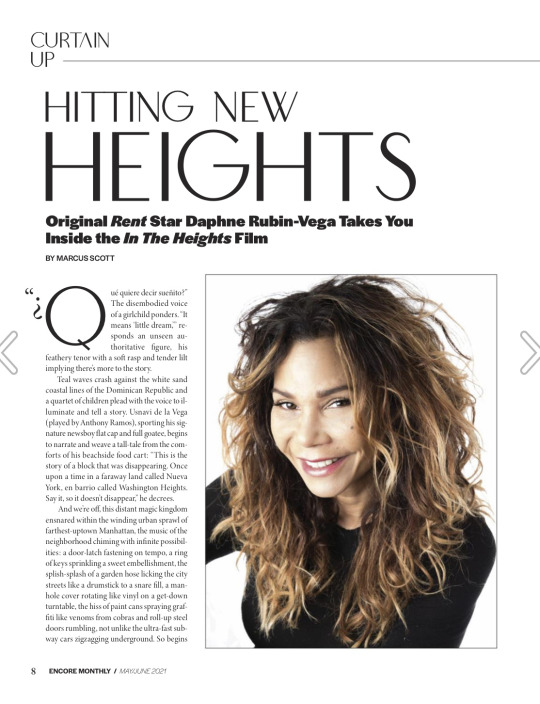
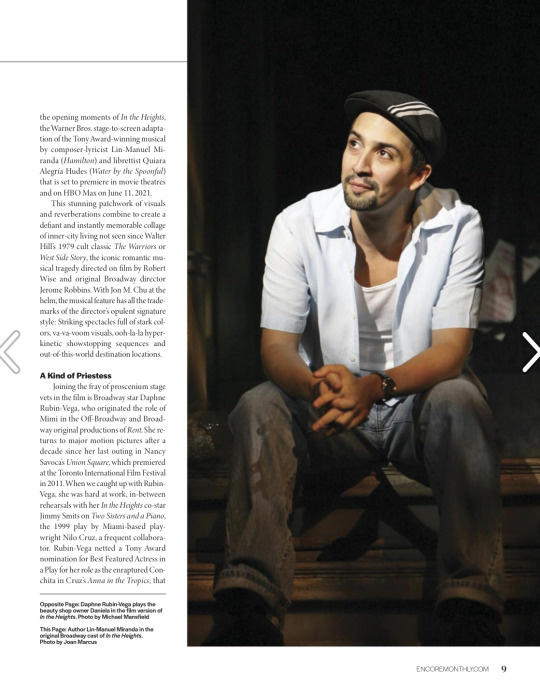
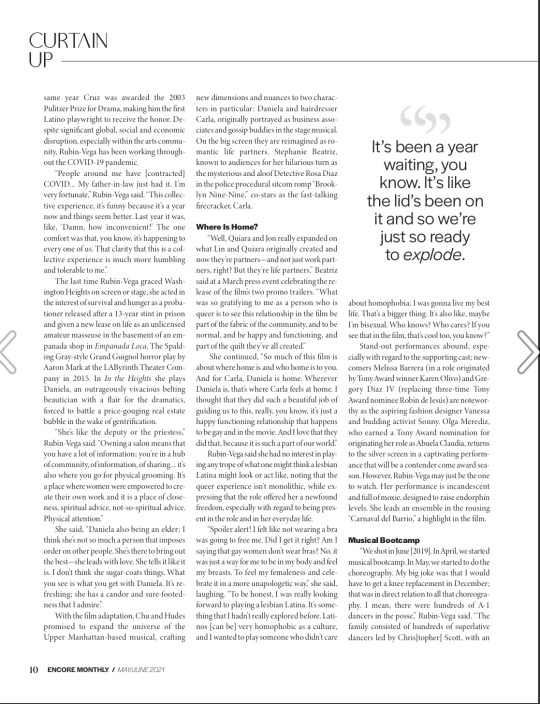
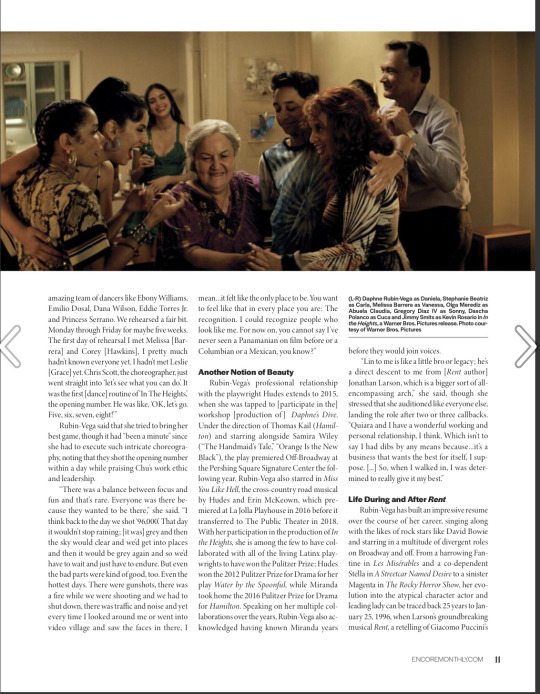

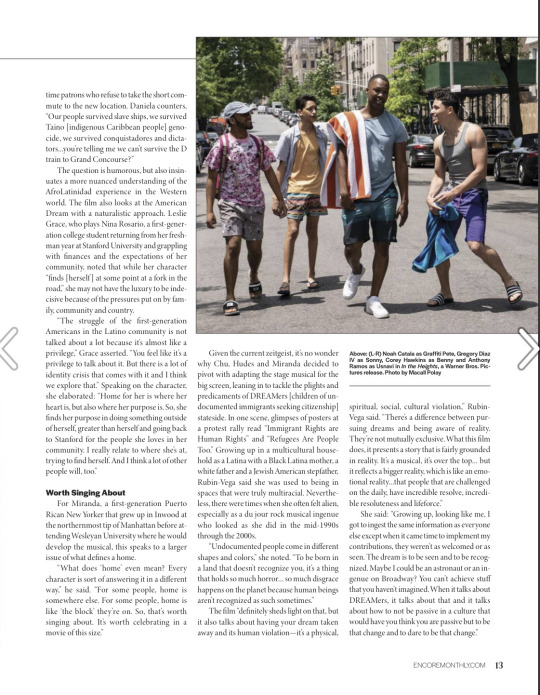

HITTING NEW HEIGHTS
BY MARCUS SCOTT
ORIGINAL RENT STAR DAPHNE RUBIN-VEGA TAKES YOU INSIDE THE IN THE HEIGHTS FILM
Qué quiere decir sueñito?” The disembodied voice of a girlchild ponders. “It means ‘little dream,’” responds an unseen authoritative figure, his feathery tenor with a soft rasp and tender lilt implying there’s more to the story.
Teal waves crash against the white sand coastal lines of the Dominican Republic and a quartet of children plead with the voice to illuminate and tell a story. Usnavi de la Vega (played by Anthony Ramos), sporting his signature newsboy flat cap and full goatee, begins to narrate and weave a tall-tale from the comforts of his beachside food cart: “This is the story of a block that was disappearing. Once upon a time in a faraway land called Nueva York, en barrio called Washington Heights. Say it, so it doesn’t disappear,” he decrees.
And we’re off, this distant magic kingdom ensnared within the winding urban sprawl of farthest-uptown Manhattan, the music of the neighborhood chiming with infinite possibilities: a door-latch fastening on tempo, a ring of keys sprinkling a sweet embellishment, the splish-splash of a garden hose licking the city streets like a drumstick to a snare fill, a manhole cover rotating like vinyl on a get-down turntable, the hiss of paint cans spraying graffiti like venoms from cobras and roll-up steel doors rumbling, not unlike the ultra-fast subway cars zigzagging underground. So begins the opening moments of In the Heights, the Warner Bros. stage-to-screen adaptation of the Tony Award-winning musical by composer-lyricist Lin-Manuel Miranda (Hamilton) and librettist Quiara Alegría Hudes (Water by the Spoonful) that is set to premiere in movie theatres and on HBO Max on June 11, 2021.
This stunning patchwork of visuals and reverberations combine to create a defiant and instantly memorable collage of inner-city living not seen since Walter Hill’s 1979 cult classic The Warriors or West Side Story, the iconic romantic musical tragedy directed on film by Robert Wise and original Broadway director Jerome Robbins. With Jon M. Chu at the helm, the musical feature has all the trademarks of the director’s opulent signature style: Striking spectacles full of stark colors, va-va-voom visuals, ooh-la-la hyperkinetic showstopping sequences and out-of-this-world destination locations.
WANT TO SEE MORE STORIES LIKE THIS?
SUBSCRIBE NOW
A Kind of Priestess
Joining the fray of proscenium stage vets in the film is Broadway star Daphne Rubin-Vega, who originated the role of Mimi in the Off-Broadway and Broadway original productions of Rent. She returns to major motion pictures after a decade since her last outing in Nancy Savoca’s Union Square, which premiered at the Toronto International Film Festival in 2011. When we caught up with Rubin-Vega, she was hard at work, in-between rehearsals with her In the Heights co-star Jimmy Smits on Two Sisters and a Piano, the 1999 play by Miami-based playwright Nilo Cruz, a frequent collaborator. Rubin-Vega netted a Tony Award nomination for Best Featured Actress in a Play for her role as the enraptured Conchita in Cruz’s Anna in the Tropics; that same year Cruz was awarded the 2003 Pulitzer Prize for Drama, making him the first Latino playwright to receive the honor. Despite significant global, social and economic disruption, especially within the arts community, Rubin-Vega has been working throughout the COVID-19 pandemic.
“People around me have [contracted] COVID… My father-in-law just had it. I’m very fortunate,” Rubin-Vega said. “This collective experience, it’s funny because it’s a year now and things seem better. Last year it was, like, ‘Damn, how inconvenient!’ The one comfort was that, you know, it’s happening to every one of us. That clarity that this is a collective experience is much more humbling and tolerable to me.”
The last time Rubin-Vega graced Washington Heights on screen or stage, she acted in the interest of survival and hunger as a probationer released after a 13-year stint in prison and given a new lease on life as an unlicensed amateur masseuse in the basement of an empanada shop in Empanada Loca, The Spalding Gray-style Grand Guignol horror play by Aaron Mark at the LAByrinth Theater Company in 2015. In In the Heights she plays Daniela, an outrageously vivacious belting beautician with a flair for the dramatics, forced to battle a price-gouging real estate bubble in the wake of gentrification.
“She’s like the deputy or the priestess,” Rubin-Vega said. “Owning a salon means that you have a lot of information; you’re in a hub of community, of information, of sharing… it’s also where you go for physical grooming. It’s a place where women were empowered to create their own work and it is a place of closeness, spiritual advice, not-so-spiritual advice. Physical attention.”
She said, “Daniela also being an elder; I think she’s not so much a person that imposes order on other people. She’s there to bring out the best—she leads with love. She tells it like it is. I don’t think she sugar-coats things. What you see is what you get with Daniela. It’s refreshing; she has a candor and sure-footedness that I admire.”
With the film adaptation, Chu and Hudes promised to expand the universe of the Upper Manhattan-based musical, crafting new dimensions and nuances to two characters in particular: Daniela and hairdresser Carla, originally portrayed as business associates and gossip buddies in the stage musical. On the big screen they are reimagined as romantic life partners. Stephanie Beatriz, known to audiences for her hilarious turn as the mysterious and aloof Detective Rosa Diaz in the police procedural sitcom romp “Brooklyn Nine-Nine,” co-stars as the fast-talking firecracker, Carla.
It’s been a year waiting, you know. It’s like the lid’s been on it and so we’re just so ready to explode.
Where Is Home?
“Well, Quiara and Jon really expanded on what Lin and Quiara originally created and now they’re partners—and not just work partners, right? But they’re life partners,” Beatriz said at a March press event celebrating the release of the film’s two promo trailers. “What was so gratifying to me as a person who is queer is to see this relationship in the film be part of the fabric of the community, and to be normal, and be happy and functioning, and part of the quilt they’ve all created.”
She continued, “So much of this film is about where home is and who home is to you. And for Carla, Daniela is home. Wherever Daniela is, that’s where Carla feels at home. I thought that they did such a beautiful job of guiding us to this, really, you know, it’s just a happy functioning relationship that happens to be gay and in the movie. And I love that they did that, because it is such a part of our world.”
Rubin-Vega said she had no interest in playing any trope of what one might think a lesbian Latina might look or act like, noting that the queer experience isn’t monolithic, while expressing that the role offered her a newfound freedom, especially with regard to being present in the role and in her everyday life.
“Spoiler alert! I felt like not wearing a bra was going to free me. Did I get it right? Am I saying that gay women don’t wear bras? No, it was just a way for me to be in my body and feel my breasts. To feel my femaleness and celebrate it in a more unapologetic way,” she said, laughing. “To be honest, I was really looking forward to playing a lesbian Latina. It’s something that I hadn’t really explored before. Latinos [can be] very homophobic as a culture, and I wanted to play someone who didn’t care about homophobia; I was gonna live my best life. That’s a bigger thing. It’s also like, maybe I’m bisexual. Who knows? Who cares? If you see that in the film, that’s cool too, you know?”
Stand-out performances abound, especially with regard to the supporting cast; newcomers Melissa Barrera (in a role originated by Tony Award winner Karen Olivo) and Gregory Diaz IV (replacing three-time Tony Award nominee Robin de Jesús) are noteworthy as the aspiring fashion designer Vanessa and budding activist Sonny. Olga Merediz, who earned a Tony Award nomination for originating her role as Abuela Claudia, returns to the silver screen in a captivating performance that will be a contender come award season. However, Rubin-Vega may just be the one to watch. Her performance is incandescent and full of moxie, designed to raise endorphin levels. She leads an ensemble in the rousing “Carnaval del Barrio,” a highlight in the film.
Musical Bootcamp
“We shot in June [2019]. In April, we started musical bootcamp. In May, we started to do the choreography. My big joke was that I would have to get a knee replacement in December; that was in direct relation to all that choreography. I mean, there were hundreds of A-1 dancers in the posse,” Rubin-Vega said. “The family consisted of hundreds of superlative dancers led by Chris[topher] Scott, with an amazing team of dancers like Ebony Williams, Emilio Dosal, Dana Wilson, Eddie Torres Jr. and Princess Serrano. We rehearsed a fair bit. Monday through Friday for maybe five weeks. The first day of rehearsal I met Melissa [Barrera] and Corey [Hawkins], I pretty much hadn’t known everyone yet. I hadn’t met Leslie [Grace] yet. Chris Scott, the choreographer, just went straight into ‘let’s see what you can do.’ It was the first [dance] routine of ‘In The Heights,’ the opening number. He was like, ‘OK, let’s go. Five, six, seven, eight!’”
Rubin-Vega said that she tried to bring her best game, though it had “been a minute” since she had to execute such intricate choreography, noting that they shot the opening number within a day while praising Chu’s work ethic and leadership.
“There was a balance between focus and fun and that’s rare. Everyone was there because they wanted to be there,” she said. “I think back to the day we shot ‘96,000.’ That day it wouldn’t stop raining; [it was] grey and then the sky would clear and we’d get into places and then it would be grey again and so we’d have to wait and just have to endure. But even the bad parts were kind of good, too. Even the hottest days. There were gunshots, there was a fire while we were shooting and we had to shut down, there was traffic and noise and yet every time I looked around me or went into video village and saw the faces in there, I mean…it felt like the only place to be. You want to feel like that in every place you are: The recognition. I could recognize people who look like me. For now on, you cannot say I’ve never seen a Panamanian on film before or a Columbian or a Mexican, you know?”
Another Notion of Beauty
Rubin-Vega’s professional relationship with the playwright Hudes extends to 2015, when she was tapped to [participate in the] workshop [production of] Daphne’s Dive. Under the direction of Thomas Kail (Hamilton) and starring alongside Samira Wiley (“The Handmaid’s Tale,” “Orange Is the New Black”), the play premiered Off-Broadway at the Pershing Square Signature Center the following year. Rubin-Vega also starred in Miss You Like Hell, the cross-country road musical by Hudes and Erin McKeown, which premiered at La Jolla Playhouse in 2016 before it transferred to The Public Theater in 2018. With her participation in the production of In the Heights, she is among the few to have collaborated with all of the living Latinx playwrights to have won the Pulitzer Prize; Hudes won the 2012 Pulitzer Prize for Drama for her play Water by the Spoonful, while Miranda took home the 2016 Pulitzer Prize for Drama for Hamilton. Speaking on her multiple collaborations over the years, Rubin-Vega also acknowledged having known Miranda years before they would join voices.
“Lin to me is like a little bro or legacy; he’s a direct descent to me from [Rent author] Jonathan Larson, which is a bigger sort of all-encompassing arch,” she said, though she stressed that she auditioned like everyone else, landing the role after two or three callbacks. “Quiara and I have a wonderful working and personal relationship, I think. Which isn’t to say I had dibs by any means because…it’s a business that wants the best for itself, I suppose. […] So, when I walked in, I was determined to really give it my best.”
Life During and After Rent
Rubin-Vega has built an impressive resume over the course of her career, singing along with the likes of rock stars like David Bowie and starring in a multitude of divergent roles on Broadway and off. From a harrowing Fantine in Les Misérables and a co-dependent Stella in A Streetcar Named Desire to a sinister Magenta in The Rocky Horror Show, her evolution into the atypical character actor and leading lady can be traced back 25 years to January 25, 1996, when Larson’s groundbreaking musical Rent, a retelling of Giacomo Puccini’s 19th-century opera La Bohème, premiered at the New York Theatre Workshop. On the morning of the first preview, Larson suffered an aortic dissection, likely from undiagnosed Marfan’s syndrome and died at the age of 35, just ten days shy of what would have been his 36th birthday.
On April 29, 1996, due to overwhelming popularity, Rent transferred to Nederlander Theatre on Broadway, tackling contemporary topics the Great White Way had rarely seen, such as poverty and class warfare during the AIDS epidemic in New York City’s gritty East Village at the turn of the millennium. Rubin-Vega would go on to be nominated for the Tony Award for Best Performance by a Leading Actress in a Musical for her role as sex kitten Mimi Márquez, an HIV-positive heroin addict and erotic dancer.
The show became a cultural phenomenon, receiving several awards including the Pulitzer Prize for Drama and four Tony Awards, including Best Musical. Rubin-Vega and members of the original Broadway cast were suddenly overnight sensations, recording “Seasons of Love” alongside music icon Stevie Wonder, receiving a photo shoot with Vanity Fair and landing the May 13, 1996 cover of Newsweek. Throughout its 12-year Broadway run, many of the show’s original cast members and subsequent replacements would go on to be stars, including Renée Elise Goldsberry, who followed in Rubin-Vega’s footsteps to play the popular character before originating the role of Angelica Schuyler in Hamilton, for which she won the 2016 Tony Award for Best Featured Actress in a Musical.
When the screen adaptation of Rent hit cinemas in 2005 under the direction of Chris Columbus, Rubin-Vega’s conspicuous absence came as a blow to longtime fans. The confluence of pregnancy with the casting and filming process of Rent hindered her from participating at the time. The role was subsequently given to movie star Rosario Dawson.
“First of all, if you’re meant to be in a film, you’re meant to be in it,” Rubin-Vega said. “That’s just the way it goes. It took a quarter of a century but this [In the Heights] is a film that I wanted to make, that I felt the elements sat right. I always felt that Rent was a little bit darker than all that. Rent to me is Rated R. In The Heights is not. It’s also a testament. Unless it’s sucking your soul and killing you softly or hardly, just stick with it. This is a business and I keep forgetting it’s a business because actors just want to show art. So, it’s really wonderful when you get a chance to say what you mean and mean what you say with your work. It’s a really wonderful gift.”
Rarely-Explored Themes
Like Larson’s award-winning show and the film adapted from it, In The Heights is jam-packed with hard-hitting subject matter, addressing themes of urban blight, immigration, gentrification, cultural identity, assimilation and U.S. political history. When Rubin-Vega’s character Daniela and her partner were priced out of the rent for her salon, most of her clientele moved to the Grand Concourse Historic District in the Bronx. Her salon, a bastion of the community, is met with a polar response when she announces she’s joining the mass exodus with the other victims of gentrification who were pushed out by rising rents. The news is met with negative response from long-time patrons who refuse to take the short commute to the new location. Daniela counters, “Our people survived slave ships, we survived Taino [indigenous Caribbean people] genocide, we survived conquistadores and dictators…you’re telling me we can’t survive the D train to Grand Concourse?”
The question is humorous, but also insinuates a more nuanced understanding of the AfroLatinidad experience in the Western world. The film also looks at the American Dream with a naturalistic approach. Leslie Grace, who plays Nina Rosario, a first-generation college student returning from her freshman year at Stanford University and grappling with finances and the expectations of her community, noted that while her character “finds [herself] at some point at a fork in the road,” she may not have the luxury to be indecisive because of the pressures put on by family, community and country.
“The struggle of the first-generation Americans in the Latino community is not talked about a lot because it’s almost like a privilege,” Grace asserted. “You feel like it’s a privilege to talk about it. But there is a lot of identity crisis that comes with it and I think we explore that.” Speaking on the character, she elaborated: “Home for her is where her heart is, but also where her purpose is. So, she finds her purpose in doing something outside of herself, greater than herself and going back to Stanford for the people she loves in her community. I really relate to where she’s at, trying to find herself. And I think a lot of other people will, too.”
Worth Singing About
For Miranda, a first-generation Puerto Rican New Yorker that grew up in Inwood at the northernmost tip of Manhattan before attending Wesleyan University where he would develop the musical, this speaks to a larger issue of what defines a home.
“What does ‘home’ even mean? Every character is sort of answering it in a different way,” he said. “For some people, home is somewhere else. For some people, home is like ‘the block’ they’re on. So, that’s worth singing about. It’s worth celebrating in a movie of this size.”
Given the current zeitgeist, it’s no wonder why Chu, Hudes and Miranda decided to pivot with adapting the stage musical for the big screen, leaning in to tackle the plights and predicaments of DREAMers [children of undocumented immigrants seeking citizenship] stateside. In one scene, glimpses of posters at a protest rally read “Immigrant Rights are Human Rights” and “Refugees Are People Too.” Growing up in a multicultural household as a Latina with a Black Latina mother, a white father and a Jewish American stepfather, Rubin-Vega said she was used to being in spaces that were truly multiracial. Nevertheless, there were times when she often felt alien, especially as a du jour rock musical ingenue who looked as she did in the mid-1990s through the 2000s.
“Undocumented people come in different shapes and colors,” she noted. “To be born in a land that doesn’t recognize you, it’s a thing that holds so much horror… so much disgrace happens on the planet because human beings aren’t recognized as such sometimes.”
The film “definitely sheds light on that, but it also talks about having your dream taken away and its human violation—it’s a physical, spiritual, social, cultural violation,” Rubin-Vega said. “There’s a difference between pursuing dreams and being aware of reality. They’re not mutually exclusive. What this film does, it presents a story that is fairly grounded in reality. It’s a musical, it’s over the top… but it reflects a bigger reality, which is like an emotional reality…that people that are challenged on the daily, have incredible resolve, incredible resoluteness and lifeforce.”
She said: “Growing up, looking like me, I got to ingest the same information as everyone else except when it came time to implement my contributions, they weren’t as welcomed or as seen. The dream is to be seen and to be recognized. Maybe I could be an astronaut or an ingenue on Broadway? You can’t achieve stuff that you haven’t imagined. When it talks about DREAMers, it talks about that and it talks about how to not be passive in a culture that would have you think you are passive but to be that change and to dare to be that change.”
Dreams Come True
Dreams are coming true. Alongside the nationwide release of the much-anticipated film, Random House announced it will publish In the Heights: Finding Home, which will give a behind-the-scenes look at the beginnings of Miranda’s 2008 breakout Broadway debut and journey to the soon-to-be-released film adaptation. The table book will chronicle the show’s 20-year voyage from page to stage—from Miranda’s first drawings at the age of 19 to lyric annotations by Miranda and essays written by Hudes to never-before-seen photos from productions around the world and the 2021 movie set. It will be released to the public on June 22, eleven days after the release of the film; an audiobook will be simultaneously released by Penguin Random House Audio.
Hinting at the year-long delay due to the pandemic, Rubin-Vega said, “It’s been a year waiting, you know. It’s like the lid’s been on it and so we’re just so ready to explode.”
Bigger Dreams
“Jon [Chu], I think, dreams bigger than any of us dare to dream in terms of the size and scope of this,” Miranda said. “We spent our summer [in 2018] on 175th Street. You know, he was committed to the authenticity of being in that neighborhood we [all] grew up in, that we love, but then also when it comes to production numbers, dreaming so big. I mean, this is a big movie musical!”
Miranda continued, “We’re so used to asking for less, just to ask to occupy space, you know? As Latinos, we’re, like, ‘Please just let us make our little movie.’ And Jon, every step of the way, said, like, ‘No, these guys have big dreams. We’re allowed to go that big!’ So, I’m just thrilled with what he did ’cause I think it’s bigger than any of us ever dreamed.”
Speaking at the online press conference, Miranda said, “I’m talking to you from Washington Heights right now! I love it here. The whole [movie] is a love letter to this neighborhood. I think it’s such an incredible neighborhood. It’s the first chapter in so many stories. It’s a Latinx neighborhood [today]. It was a Dominican neighborhood when I was growing up there in the ’80s. But before that it was an Irish neighborhood and Italian. It’s always the first chapter in so many American stories.”
#Marcus Scott#MarcusScott#Write Marcus#writemarcus#Encore Monthly#theatre#Theater#Musical Theatre#musical theater#daphne rubin vega#rent#rent musical#Jon M Chu#lin manuel miranda#in the heights#Anthony Ramos
72 notes
·
View notes
Text
Loki Meta Nobody Asked For, part 3--All MCU Lokis are AU fan fiction Lokis
There is so much in part 3 that I really wanted to see and I very much want to celebrate, but once again, I am conflicted.
Ok. Good things: Loki and his magic. Loki and fighting. Loki and improvisation. Loki as bisexual. Loki talking about his mother. Loki showing a moral compass.
All of these are Most Excellent Things: • Loki here is finally not a de-powered pushover. His illusions are effective. He teleports over a short distance. He resists Sylvie’s mind control. He stops a multi-ton support tower from falling and pushes it back up into place!!!! • He fights effectively--finally! Granted, his dagger misses its mark, but he was drunk, so I’ll give him a pass on that. Aside from that, he finally shows us some highly effective hand-to-hand combat skills. Thankyouverymuch for acknowledging that Loki survived a millennia of life in a warrior culture. He was raised by a warrior king. His brother is a Hero(tm). There’s no way he didn’t learn some skillz. His ineffective fighting in episode 2 can easily be attributed to the fact that he was pulling his punches when he was fighting the human shields Silvie possessed. • Loki’s character explicitly acknowledged their queerness!!!! This makes my little queer heart glow bright, and I think needs no more comment. Just . . . yesssss! • Loki loves his mom. Loki is conflicted about that relationship because They Lied To Him. And did I mention that Loki speaks wistfully about his mother and a bit about the fact he was adopted and no one told him until he already pretty much found out (in the most awkward way ever). Even Sylvie thought that was pretty poor parenting. Good stuff. • Loki really doesn’t want to kill innocent bystanders and only attacks folks who attack him first. He is also kind of appalled to hear that the TVA workers are all variants who’ve had their minds wiped. Again, this is all excellent, and fits well with the Loki we met in Thor I who just really wanted to make sure his war-mongering brother didn’t sit on the throne until he grew up a bit, and then Everything Got Way Out of Control. • We see Smart!Loki in action, as opposed to hear Mobius flatter Loki to get him to cooperate. While one of Loki’s attempts at deception fails miserably, the other works (with Sylvie’s help). This is all excellent and made me Very Happy Indeed!
[more below the break]
I also very much liked many parts of his interactions with Sylvie, and the fact that we got a tiny bit of her backstory (and I love her insistence on her own identity--this is very much I think a Loki thing, “I am not you. I am my own thing, thank you very much”). This relationship has a great deal of potential for complexity and depth. I am totally here for enemies to frenemies to allies if that’s where the series is going.
I like the reveal that the TVA agents are all variants themselves who have been “wiped” and indoctrinated. We are finally getting more obvious hints at the insidiousness of the TVA.
So why am I still conflicted about the series? Well, here is what I did not like: • Loki’s improvisation with the old woman--he had too little information to pull off an effective scam like that and he would have known that. He had a photograph. A black and white photograph--no voice, no personality, no coloration, no body language; he didn’t even know if the picture really was one of a husband and not some other type of relation. There was no way it would ever work. He should have known that. Loki would have known that. • His voice and body language when he pretended to be a guard was stupid and unconvincing, not mimicry. That was a joke. • The getting drunk thing. I found this not only disappointing but insulting and also possibly lazy on the part of the writers. It felt completely out of character. In fact, Sylvie felt much more “Loki-ish” in this scene than Loki did. I just cannot in any universe see Loki doing anything like this under these conditions. They are undercover in a high-pressure situation in which they are about to be wiped out of existence if they fuck things up, and Loki decides to get drunk? No. This is a virtually suicidal loss of control. They have no idea how long they would be on that train or what they would have to deal with later. They have no idea what sort of security is in place on the train. Why did they even stop in a bar, of all places? Why not find a sleeper car and stay out of the way? For that matter, why not just find seats? Why would a guard be sitting in a booth at a bar with a prisoner? They wouldn’t. Loki’s sense of self-preservation is stronger than that. He’s smarter than that. It was stupid and out of character and also unnecessary--there are so many other ways they could have gotten them shoved off that train that did not involve Loki making a spectacle of himself. It was, in fact, a very Thor thing to do, not Loki-like at all. • I still feel as though Tom is over-emoting in all of the scenes that are less than life-or-death. It does not feel like the Loki I met in Thor I and The Avengers. That Loki had a length of re-bar up his spine and only genuinely smiled when he looked at Thor (when Thor was smiling).
I feel like Tom is playing two Lokis in the show--the one that fights his way out of tight spots and occasionally deals with his difficult family issues, and the other is a parody of mischief!Loki--whose face is extremely emotive and who wants to bare his soul to whomever looks vaguely as though they’ll listen to him.
So, here’s my mid-series conclusion. All MCU Lokis are fan fiction Loki’s of the comics. Among those MCu fan fics are three distinct AUs.
1. The Loki we meet in Thor I, The Avengers, and Thor II. This Loki works hard to bury his emotions. His body language is generally stiff and prickly. He is the product of growing up in a culture that is driven by a toxic masculinity and devalues those traits that are coded “feminine” such as all of those things Loki excels at. Because of this, he has gotten the message his entire life that he is with less that the Golden Child that is Thor. He loves his brother with all his soul but resents him because his father placed them in competition with one another. All of this was reinforced by growing as the “tag-along” little brother who was tolerated but not embraced by Thor’s closest friends. This Loki becomes self-destructive and suicidal, experiencing a psychotic break as a result of revelations about his adoption and internalized racism. He spends who-knows-how-long falling through the void enduring perhaps months of sensory deprivation only to be tortured and manipulated by Thanos. He emerges from that experience Truly Fucked Up, stopped of much of his power because he’s had the living shit kicked out of him. But his core self is still there somewhere--a core self that loves his brother, that craves affection, that really hates what Asgard has done to him but still has a moral compass in there somewhere that says wiping out the entire universe is a bad thing and I guess protecting helps humans is something he ought to do since his brother loves them.
2. The Loki we meet in Ragnarok and IW. This isn’t really the same guy as Loki #1. It’s a fan fiction AU in which Loki has no trauma to deal with. He is a manipulator. But he is a manipulator because he is a survivor. He does what he has to do in order to be not dead, and if he can also have some luxury while he does it, well, that’s a bonus. Theoretically, he is a powerful mage--since he was able to overcome Odin and place him in a nursing home--but we don’t see any of that on screen. He is revered Mostly Harmless by the narrative. There is no re-bar up his ass. His body language is much more loose and emotive. His characterization has been flattened out in order to serve as a narrative foil for Thor, and will be bridged in IW to serve Thor’s character development (yet another feminization of his character). Many people really enjoyed this version of Loki. But let’s be clear, he isn’t the same Loki we met in the other three movies.
3. The TVA Loki. This Loki is a new fan fiction. A third AU. This Loki is slightly closer to Loki #1 in that his characterization is a bit more complex than Loki #2. He is smarter. He is more versatile and powerful. He has a backstory that isn’t being mocked. His queerness is not being used to villain-code him. But it would be wrong to say he’s the same Loki that we saw in the first three movies. This Loki’s trauma is all family-related, which great, at least they acknowledge that.
However, he clearly is not the PTSD!Loki that we see in TDW. They have decided (at least so far) to completely ignore what happens between Thor I and The Avengers. I’m not quite sure why it’s ok to deal with trauma when it’s Bucky Barnes and Tony Stark, but not ok when it’s Loki, but this is the decision the director made, and if I want to enjoy the show, I have to be ok with that. So that’s what I’m going to do right now. The Loki show is fan fiction. It’s an AU. And it does a pretty good job at doing that.
25 notes
·
View notes
Text
'In recent years, there have been remarkable coming-of-age films that avoid stereotyping - Aftersun, Falcon Lake, or Near. Among them is All My Strangers, a queer drama with a mysterious atmosphere. It received six BAFTA nominations and earned lead actor Andrew Scott a Golden Globe nomination. Now the movie is available on Disney+.
"Vampires are haunting my door," says drunken young Harry (Paul Mescal) to his neighbor, trying to get him to let him into his apartment. It paraphrases the well-known song The Power of Love by the pop band Frankie Goes To Hollywood, one of the important songs for the queer community in the eighties. His neighbor Adam (Andrew Scott) is a writer and in a huge London apartment building where no one lives except for the two men, he is trying to write a work through which he longs to return to his childhood.
Adam wants to support his memories, which he keeps in a dusty box, by visiting the village where he grew up. Harry and Adam gradually find their way to each other and go to visit together. However, not only an old abandoned house awaits Adam, but also his parents – enthusiastic, loving, very young and vital. Besides, there wouldn't be anything strange about it if Adam hadn't admitted to Harry that they had died in a car accident over thirty years ago.
The non-violent drawing into the story causes a pleasant confusion in the viewer: is this really the writer's way of processing the past, or on the contrary, is he uncovering hitherto unacknowledged traumas from adolescence? What did his childhood really entail? And is Adam losing his mind, or do ghosts really exist?
A very lonely life
British director Andrew Haigh (* 1974) plays a new, romantic, sparkling and natural partnership against the background of family traumas. The film All My Strangers is based on the psychological novel Strangers by the late Japanese writer Taichi Yamada, but it is more of Haigh's subjective and fragile confession. As a gay teenager in the 1980s, he experienced not only the specific separation from family that queer people often face, but also a wave of rising homophobia due to the massive spread of AIDS. And the fact that the film is a personal matter for the director can be seen in practically every scene. The house that Adam's parents live in is also the home where the director spent a significant part of his childhood. "It was a strange choice, a hard choice. But I wanted the film to have some honesty and vulnerability, to feel grounded in some reality. The only option was to make it my own reality," Haigh described to the Guardian newspaper .
The protagonist Adam thus becomes the director's alter ego. Moments when Adam's communication with his dead parents begins to border on absurdity in the audience, the director anchors with a reflection of specific memories. In the finale, we can reflect on a ghost story full of the scariest element, i.e. a confrontation with a repressed past. The line of Adam's efforts to reawaken a long-dead relationship with his mother and father can be taken as an original form of a coming-of-age story of a lonely middle-aged man. Before the fatal accident, which also took place on the eve of Christmas Day, the bullied boy did not have time to escape. He thus lacks the fundamental form of acceptance that a young gay man would have been able to obtain at that time thanks to dialogues with his parents. Although "communicating" with spirits may offer some form of reassurance, it will never be the thing for Adam to bring back his traumatic years.
The omnipresent loneliness is a burdensome element here, often reaching beyond the limits of the audience's tolerance. "They say it's a very lonely life," Adam's mother (The Crown star Claire Foy) reacts with concern when Adam tells her about his sexual orientation. "No one says that anymore," reacts the writer explosively, knowing that despite the significantly different social acceptance of queer people nowadays, loneliness is the only companion that constantly accompanies him.
The physical expression of actor Andrew Scott, who is himself gay, adds a significant level of harshness to the film's loneliness. His characteristic half-smile reflects moments of joy, while at the same time carrying as much sadness as the hero of the coming-of-age drama Aftersun . Paradoxically, this is played by the star of this film, Paul Mescal, who in All My Strangers ably supports Scott in the role of the young queer man Harry, who is lonely for other reasons. Although the family has unconditionally accepted his gender identity, he perceives that the center of attention and hope for the future are his heterosexual siblings.
Rediscovering his own queer identity through building a relationship with young Harry means a direct confrontation with past traumas for Adam in his forties. Although the focus on the writer Adam puts his story on the back burner, he also realizes what a light of hope his relationship with Adam represents for him.
will you take care of me
When the two men first go out as a couple to a gay club in central London (another place where director Haigh spent part of his youth), Adam is given a line of ketamine by his younger partner; however, he believes that Harry offered him cocaine. “Will you take care of me?” Adam asks semi-eloquently just before his traumatized mind from the past sends him into a dissociative state called the k-hole.
Throughout the film, Haigh tends towards an outward approach bordering on stereotyping gay life. Although it might seem so at first glance, his presentation of two partially different queer men does the exact opposite. Drugs were and are a very strong part not only of the club scene, but also of the social queer scene, at the same time the directing process does not glorify their use in any way, not even for the purpose of strengthening gender identity.
Haigh approaches the erotic scenes between Scott and Mescal with the same degree of individuality and sensitivity. Jamie Ramsay's camera close-ups respect the boundaries of the actors' safe space, and the director thus avoids the unnecessary bodily exploitation of queer characters, which is still quite common in Western cinema.
Also thanks to the unique directorial care, the film is a landmark in the ongoing debate about whether LGBTQ+ characters should be represented by heterosexual actors. After all, Paul Mescal himself commented on it. “It depends on who is responsible for telling the story. There have been so many offensive depictions of queer life in cinema, and that's only because the creators and actors were careless," the actor told NME .
You break the memory
Although shrouded in mystery, the final form of All My Strangers is actually a banal, yet unique narrative about the importance of coming out, self-love, and externalizing the acceptance of gender identity. Just like Marek Torčík in his debut autofiction novel Rozlóžíš paměstí , here Andrew Haigh helps his hero Adam to break down his memory, to search for the limits of realism and accuracy of memories, to follow their gradual transformation or even the formation of those that never happened.
Where the audience's willingness to accept the believability of Adam's story about communicating with his dead parents ends, the possibilities of interpreting the film also end. We can then meditate on a superficial spiritual play about sharing important life stages with parents, which he could never share due to their premature departure.
The second way, on the contrary, is to perceive the dialogues with Adam's mother and father as the writer's ultimate self-reflection, which for him means not only the topic for the novel, but also the final confrontation with the fact that some wounds cannot be healed by time.
At the same time, all my strangers are proof of the possible importance of music in visual culture. Just as director Charlotte Wells strongly supported the atmosphere of individual scenes with the use of 90s rock and pop hits in the aforementioned Aftersun , similarly Andrew Haigh works with 80s synth-pop. The final decomposition to the sounds of The Power of Love disarmingly presents the fragility and vulnerability that both heroes carry as a result of their (un)constructed solitude.
The outcome of Adam and Harry's romance can be perceived ambiguously in the finale. The direction offers two versions of the ending in a penetrating and emotional gradation: either we yearn for a romantic ending to an atypical gay romance, or we accept the fact that Adam's journey to self-acceptance and coming to terms with loneliness remains at the beginning. And until society rids itself of the patriarchal stereotyping of queer people, none of us will move from the starting line.'
#All of Us Strangers#Andrew Haigh#Andrew Scott#Paul Mescal#Frankie Goes to Hollywood#“The Power of Love”#Aftersun#BAFTA#Golden Globes#Claire Foy#Jamie Ramsay#LGBTQ+#Strangers#Taichi Yamada
0 notes
Photo

Love Thy Neighbor.
With her nineteenth-century American romance, The World to Come—starring Katherine Waterston and Vanessa Kirby—screening now, director Mona Fastvold talks to Ella Kemp about the need to create images, striving for ASMR storytelling, and just how much we owe Terrence Malick.
“We’ve seen a lot of movies during this time period in America about what the husbands were out doing… but they had wives who are at home, living their completely separate lives. What were they up to?” —Mona Fastvold
In the American Northeast in the nineteenth century, life for farmers’ wives is physical, lonely, subject to both the extremes of weather and their husbands’ moods. When Abigail (Katherine Waterston) and Tallie (Vanessa Kirby) become neighbors in The World To Come, their lives become infinitely more bearable.
What unfolds is a careful study of the ways affection and understanding can bloom in the most unlikely places. Based on Jim Shepard’s short story of the same name, Mona Fastvold’s desperately romantic film starts where Abigail’s diary also begins: with a new year, and new neighbors. Through lyrical voice-over and closely drawn scenes, Abigail tells of how, in the wake of unimaginable loss, her life is cracked wide open by the arrival of effervescent, free-spirited Tallie. She speaks of grief and exhaustion, but also of astonishment and joy.

Katherine Waterston as Abigail and Vanessa Kirby as Tallie in ‘The World to Come’. / Photo by Vlad Cioplea
It’s a story felt through whispers as much as kisses, framed by the blustery winds of the East-Coast frontier—and by the spectre of their husbands (Casey Affleck as the downcast Dyer, Christopher Abbott as the jealous, disturbing Finney) finding out about their new love. Fastvold gives each character just enough attention to let the relationships that matter most rise up all on their own. She does so with words, poetry that somehow feels alive, and with music—specifically, a stunningly passionate clarinet soundtrack.
The World to Come won the Queer Lion at Venice last August (where it miraculously had an in-person premiere), and won many more hearts at Sundance in January. It’s Fastvold’s second film as director, after 2014’s The Sleepwalker, which also starred Christopher Abbott, and was co-written by Fastvold’s partner (and Vox Lux director) Brady Corbet.
What did you feel when reading Jim’s story for the first time? Mona Fastvold: It was a home I wanted to move into. It was this feeling of thinking, ‘This belongs in my universe, and I belong in this universe.’ And I all of a sudden had a few images that I felt a very strong need to create. The first thing that I felt really compelled to do was creating this physical expression of joy after the first kiss. I had this image of Katherine in this wide shot, completely open and just exposed. And I was really compelled to shoot her in the snow by the grave as well.
I also wanted to frame her being tied to the house with a rope, working her way through the snowstorm. There was a lot of amazing text and maybe fewer images in the script, because it’s written by these two really wonderful writers and authors of novels, not so much screenplays. So it’s not a very technical screenplay, and there were a lot of things left to me to work out, which I enjoyed. But the foundation was this really good text.
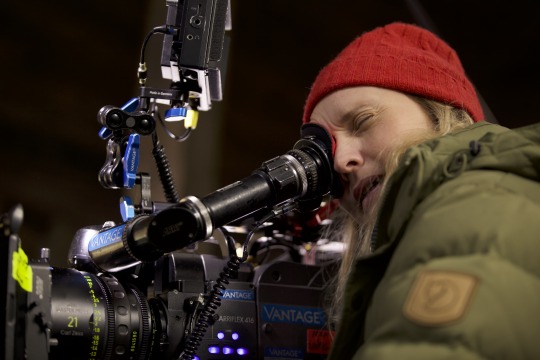
Mona Fastvold on the set of ‘The World to Come’. / Photo by Toni Salabasev
The text is so striking, in the way it’s so verbose but never feels stiff. How did you keep the words intact while bringing these emotions to life? I cast some really good actors, so that helps! Then when you’re working with this kind of text, it’s not really a text that you can improvise or play around as much, you really just need to honor it. For me it’s really about finding the movement that will support the beats of the text. I like the edit to be motivated by a gesture, something that says, “I want you to look at this”. I’m trying to make the rhythm more exciting. Ping-ponging back and forth is less exciting to me.
When rehearsing, we’d create movement either physically, or find changes through long pauses already in the text, and then upon finding those organic beats I’d figure out with my DP how we can stay in one take for as long as possible, until we find that moment which motivates a change. I never like there to be a camera movement just for there to be something cool visually. And there’s all this subtext in the text, all these messages Abigail and Tallie are trying to send to each other. When are you being direct? When are you being understood? When are you not?
Particularly in recent years, we’ve been fortunate to have a number of films that reframe period pieces about forbidden lesbian romances. Why do you think we keep coming back to this kind of story? A lot of people feel compelled to say these stories have always been there, and to claim that part of history. It’s not modern, it’s not a new thing, but it’s just that these stories have not been told much. Especially a love story that takes place among farmers. We know a little bit about upper-class stories from some literature, but not that much from that time period. So part of the appeal for me was to say: this is a part of history. Even though it’s not a story about Napoleon, this story about these two quiet, introverted women is still worth exploring. And we’ve seen a lot of movies during this time period in America about what the husbands were out doing. I’ve grown up watching these movies, but they had wives who are at home, living their completely separate lives. What were they up to?
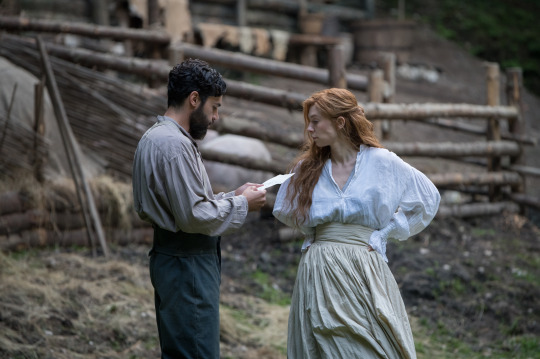
Finney (Christopher Abbott) reads Tallie’s mail. / Photo by Vlad Cioplea
You mention the husbands—I felt watching this film that it was set in a very different world to the likes of Portrait of a Lady on Fire, which a lot of people loved precisely because of how few men were in the film. But here the husbands play a really important part within the story about these two women, helping to convey their frustration and limitations, without taking over. All characters in a story deserve equal counts of love and attention from the writers, directors and actors. It was incredibly important to portray the men with as much nuance as Abigail and Tallie. It makes for a more interesting story for them, that their relationships with their partners are complex—they’re not just these male archetypes who are terrible and awful. Dyer was an interesting character, in that he’s striving to understand even though he doesn’t quite. And he had different ambitions as well, but this is the situation he’s in, and he’s chosen a practical partner who he respects, and I guess loves and cares for. But they’re running a farm together, they’re business partners as well and depend on each other for survival. When he says “I’ll die without you” it’s quite literal, in a way. I wanted to break these characters open and make them more difficult to deal with, for themselves and for the women as well.
Your picture includes a beautiful, and really unexpected score by Daniel Blumberg—particularly in the use of the clarinet, which feels like its own kind of narrative. Can you talk me through the process of weaving that into the story? I brought in Daniel even when I was developing the script and working on casting early on. I kept listening to ‘Three Pieces for Solo Clarinet’ by Igor Stravinsky, and somehow the instrument felt really connected to Katherine’s voice-over. It was important that the voice-over was not slammed on top at the end. It’s there, I hope, to have a bit of an ASMR effect where you feel it draws you really close to Abigail in a hypnotic way. That you feel like you get this intimate experience of that character by having access to her life even if it doesn’t explain things too much.
So we wanted to have the score speaking to the voice-over, which we recorded long before we started shooting as well. We would play it on set and Daniel would come in and play music there. So constantly being in dialogue between the text being read and the music being played was an important part of the process.
It’s time for some Life in Film questions. What is your favorite ‘forbidden love’ story? A film I really love, which inspired The World to Come, is Olivia. It’s from 1951 and it’s directed by Jacqueline Audry, and it was one of the first lesbian on-screen kisses ever captured. It’s a great movie directed by a female director when that wasn’t so much of a thing. It was an important trailblazer for this film.
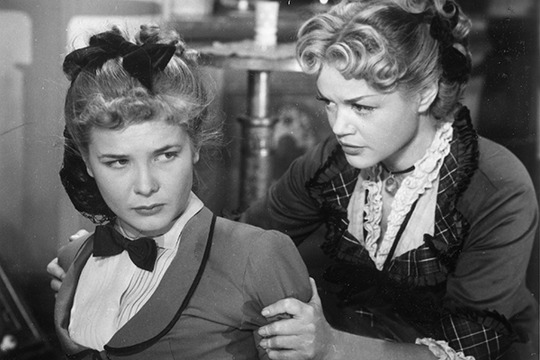
Marie-Claire Olivia and Simone Simon in Jacqueline Audry’s ‘Olivia’ (1951).
What’s your favourite “Dear Diary” movie, the one that best uses a confessional voice-over? Terrence Malick pretty much cornered that market with some beautiful, beautiful attempts at that. We definitely have to pay our respects! Particularly Days of Heaven is pretty amazing. The voice-over work there is extraordinary.
What is your go-to comfort movie? It’s funny because I was asked that a while ago and normally I would just be like, “Anything Nancy Meyers makes is just so lovely”. She makes these films that are just like candy. But during the pandemic, it’s just too hard to watch these cozy movies, because it just makes you feel depressed. So right now, the film I’ve watched the most in my lifetime is Eyes Wide Shut. I also find it to be a Christmas movie… If it’s on anywhere, I’ll always leave it on, or just watch a little piece of it.
What should Letterboxd members watch after The World to Come? First of all they should watch Olivia if they haven’t seen it, and then the other day I watched Martin Eden—it’s an incredible movie. So beautifully made.
What is the one film that first made you want to be a filmmaker? I grew up watching a lot of movies. My family are cinephiles and I’ve always loved films. I grew up on a steady diet of Ingmar Bergman’s films during my teenage years, and Tarkovsky too. Seeing those films made a really big impression me. But what really inspired me in many ways was seeing Claire Denis’ films. The way she approaches storytelling is so intuitive. It’s so exciting. That resonated with me, and later on I recognized some of that in Lucrecia Martel as well. I just love how she handles time and logic and character.
Related content
120 Lesbian Films to Watch Before Saying All Lesbian Cinema is the Same
Pride: A Chronological History of Queer Interest and LGBTQ+ Cinema
Films Directed by Women
Follow Bleecker Street on Letterboxd
Follow Ella on Letterboxd
‘The World to Come’ is currently in select US theaters, and will be available on demand from March 2, via Bleecker Street.
#mona fastvold#the world to come#katherine waterston#vanessa kirby#casey affleck#christopher abbott#period romance#period film#period cinema#forbidden love#lesbian cinema#lesbian film#lgbtqia#lgbtq#lgbt cinema#lgbt film#sundance#sundance film festival#venice#venice film festival#queer lion#queer cinema#queer movies#queer romance#letterboxd
58 notes
·
View notes
Text
What We Do in the Shadows Season 3: Harvey Guillén Wants Buffy to Train Guillermo
https://ift.tt/eA8V8J
This article contains spoilers for What We Do in the Shadows season 3 episode 3.
Things have changed for the Staten Island vampires on What We Do in the Shadows season 3 as they step into positions of power. This may not make much of a difference for Colin Robinson (Mark Proksch), whose new job as secretary of the Vampiric Council, is much like his fake job, at a cubicle in an office. But Laszlo (Matt Berry) may spend a little more in the potting shed. His love Nadja (Natasia Demetriou), is running the council, along with Nandor (Kayvan Novak), who’s familiar, Guillermo (Harvey Guillén), has been promoted to the position of bodyguard. It was easier than killing him.
Based on the 2014 feature film by Jemaine Clement and Taika Waititi, What We Do in the Shadows follows four vampires, who have been roommates for longer than anyone cares to remember, as they cope with life in the modern world. Which is not held up on the shoulders of four horses.
Nandor the Relentless was a fierce and terrible Ottoman warrior, known for pillaging villages and turning the Euphrates red with blood. Guillermo worked at Panera Bread. The bond that ties vampire to familiar is a strange one. The pay isn’t great, the hours are daunting, and they don’t get employee-of-the-month plaques. The only real incentive is the promise of everlasting life as a ravenous bloodsucking fiend, and there is something of a hiring freeze at the moment.
British Iranian actor and voice artist Kayvan Novak co-created and starred in the British prank show, Fonejacker, and also can be seen alongside Matt Damon and George Clooney in Syriana, as well as the films Cuban Fury and the Walt Disney live action remake of Cruella. He plays three different characters in Men in Black: International. Harvey Guillén acted in the movies The Internship and in Netflix’s Truth or Dare, and his TV works include The Magicians, and Zoey’s Extraordinary Playlist. He earned a GLAAD Media Award his role in the “Don’t Ask, Don’t Tell Me What to Do” episode of Raising Hope, and made LGBTQ+ Latinx history by becoming the first queer Latinx actor to be nominated for Best Supporting Actor at the Critics’ Choice Award for his role as Guillermo de la Cruz. Starting Sept. 2, Guillén will also host After the Shadows, a new talk show following and discussing What We Do in the Shadows.
Novak and Guillén hovered over Den of Geek to speak about Nandor and Guillermo’s new job descriptions, as well as old habits, cloaks of many voices, and Van Helsing DNA.
Den of Geek: I wanted to congratulate you on your characters’ new duties. Is it more fun running vampires or running from them?
Kayvan Novak: Has Nandor run from a vampire? I guess I have. I think they’re equally as exhilarating and frightening.
Harvey Guill��n: I would say fighting the vampires is exciting with all the combat when that opportunity comes up. Yeah.
Guillermo took out the entire local vampire command, but couldn’t stake a vampire council docent. Is Guillermo getting soft?
Guillén: I don’t think he’s getting soft. I think the only reason that he even put himself in that scenario is because he knew that his old housemates, because remember he moved out of the house, his old housemates were in danger. I think at the end of the day we forget that he had mostly only humans in the house. And you know, what separates us from everything else in the world is that humans are driven by emotion and have a conscience and have a heart. So he couldn’t live with himself, if he knew that they were set up by the Vampiric Council to be eliminated at this theater. That’s the only reason he goes and saves his chosen family. Even though they’re total assholes to him, he is still loyal at the end of the day. He’s still loyal to these four vampires, especially Nandor. I think that he’s not getting soft. He’s just starting to see what’s important to him and what’s worth fighting for.
Did the “Cloak of Duplication” episode come up because you were already doing the impressions?
Novak: I guess the writers had an idea. They had a sense that I was a bit of a mimic and I liked doing impersonations. And I think they decided to kind of craft an episode around that. I was slightly apprehensive of the number of impressions that they thought I could do considering I had to do all of my castmates who, although I could do impressions of some of them, I’d never done it to their faces. So it was a new challenge. Not only to learn very quickly how to impersonate them with their help, because they helped me along the way, and they told me how to deliver some of the lines. But then having to do that in front of them, it took some concentration.
Whose voice was the easiest?
Novak: I guess the easiest, or the one that I had done was Colin Robinson. Because he’s got a very specific [voice]. It’s kind of the closest to mine in a way. And the rhythms of it, very specific. Nadja’s voice and Kristen [Schaal]’s voice, I couldn’t actually do. I can only kind of do their physicality. So, the voices you hear are not my voice. They’re the voices of the actual actors. Guillermo’s voice, Guillermo’s delivery, that took a minute to kind of get into that groove. And then Matt Berry, Laszlo’s character, I’d never really tried an impression of him. And it was really more the physicality that I got into to deliver those lines in that rhythm, that really was the key in. Because you’re always trying to find the key in.
Harvey, what was it like hearing Guillermo come out of Novak’s throat?
Guillén: It was great. Because I’ve seen Kayvan do impersonations of everyone, he’s a master. I don’t think I’ve ever seen him do me in a full scene. Like he would make a good joke or mimic me and say, “Yeah, yeah, now my friend,” and he does like a caricature of my voice, which is always fun, but yeah, “you’re my best buddy,” that’s like an ongoing joke on set that he always does. But to really kind of do it and kind of really capture Guillermo’s inflections and the volume where he placed him. I was like, oh my gosh, this is great. I was in awe. Like I was like, this is great. I had to do a double take, like that’s not me. That’s wait. That’s not me. Okay.
Blade, Buffy, the Frog brothers, and now Guillermo. Guillermo is the descendant of the greatest Slayer of all slayers. Is this nepotism?
Guillén: I don’t know if it’s nepotism because I don’t think he’s gotten anything handed to him. And he’s worked really hard for everything he has, and even now being the descendant of Van Helsing, it’s still not easy. Now, it comes with another wagon full of problems and choices to be made and predicaments that he now has with his housemates. But I would love to see some of those legendary slayers and chosen ones make an appearance and guide him, maybe help him out. Maybe Buffy pops in and says, I’ll show you how it’s done. That’d be great. Or Blade comes back, Wesley Snipes comes back. We’ve already had him. Who knows? But yeah, I would love to see someone show him the ropes or take them under their wing or, he’s learning by trial and error. And I think so far he’s doing okay. So maybe he’s a self-made Slayer in his own way.
When Nandor and Nadja were introducing themselves to the rogue vampires, you are each soloing, but hitting the beats at the same time. Can you just walk me through the rehearsal of the timing?
Novak: I think to really nail a scene like that, we’re both kind of focused on the direction of, I think Yana Gorskaya directed that scene. And that was just a case of us kind of working together, but also allowing her to kind of pull us through the scene to make sure that we hit those marks perfectly. It took some practice, took a few takes, took rehearsal, but you always know you’re going to get it. And you know that if you’ve got to get something that’s a bit of a challenge to get to, you want to be in the right company. And, and thankfully, we are because we’re in each other’s company.
Harvey, when you interject objections and you break and you look at the camera, they’re like hi-hat taps, are these scripted or are you doing it strictly on an intuitive basis?
Guillén: No, I don’t think I’ve ever seen it scripted for Guillermo that he looks at the camera. I think we do, as we do a rehearsal and we have our DP and our director follow us through rehearsal and whatever feels organic in the moment, there has to be an organic beat. Right? So, if it’s, most of the time it is Guillermo, because he’s the only human in the room, aside from the camera crew. And so, when he looks at the camera crew, it’s like, oh God, you’re going to film this, aren’t you? And the camera catches that moment. And it zooms into it. It’s like, you’re not, oh no, it’s incriminating. And so, as you connect with another human. Did you hear what he said? Or did you, I can’t believe they’re talking like this because who are you going to connect with the vampires who live in their own world of lust and pleasure and feeding. They don’t care, they’re immortal, but the humans in the room are like, we can go to jail at any moment for a lot of these things. I can get in trouble myself.
So, most of the time, when Guillermo looks at the camera, it’s either out of fear or it’s either like I’m smarter than them and you see that, right? So it’s like you saw that, right? But he can never say it. So he can’t verbally say what he’s feeling. So, their face does it all for you to the camera.
Did Guillermo and Nandor meet at Panera Bread?
Guillén: We talked about this. I think the idea that, if he was working at Panera Bread, it must have been shortly after high school or something. And somewhere along the lines, he must’ve met Nandor, he must’ve come in when Panera was closing and maybe tried to feast on him? Maybe, I don’t know. The backstory I gave myself was, he convinced Nandor not to feast on him and kill him, but to service him in return to become a vampire. That’s the backstory I gave myself. But Kayvan, what do you think?
Novak: I think whatever happened there’s CCTV footage of it-
Guillén: Somewhere. Yeah.
Novak: And I think that would be the best way of revisiting that because, if they didn’t have a documentary crew following them, then they’re relying on kind of just, incidental cameras, capturing stuff. I think it would be cool.
Guillén: I think that’s cool. Yeah.
Nandor is 758 years old, and going through an eternal life crisis. Is he becoming too Americanized or does Nadja have a point about there not being anything more to existence than just slaughter?
Novak: It’s a funny one because he’s been around so long, you’re supposed to eventually just blend into your environment and be taken over by and become an American or become a Staten Islander. And for some reason they live in such an insular world that they resisted this. But now for some reason, whether it be an emotional light that’s gone off in his head, he’s decided that no, he wants to humanize himself more and, yeah, be more like the people that he kills, almost. The world that he feeds off. He wants to be part of that. And I think, Nadja, she’s the cynic she’s like, stop dreaming. Stop. You know, there’s always that person that’s like, yeah, you could do that. But there’s lots of people that want to do that too, you know? And you’re like, oh, you’re right. I better not waste my time chasing pipe dreams. There’s always that person in the room and that person, for Nandor, is Nadja.
What’s it like to act against Nadja’s doll?
Guillén: Such a diva. Yeah. Difficult. Late to set. She always has to be carried. I don’t know if it’s in her rider, but the doll has to be carried by two, like men-
Novak: Dressed in green.
Guillén: Dressed in green. Yeah.
Novak: I actually did have to do a couple of scenes where there’s a montage sequence with me and the doll and we actually got onto some really funny stuff. I was teaching her sword fighting, a bit of a spoiler, but it’s very quick. I don’t know if it made it in but I was teaching her sword fighting and then I was like, well, we might as well have a sword fight. And then she disarms me and then she chases after me and I run. But I don’t know if that made it in the cut. I just decided that would have been a funny thing to do. To be disarmed by this doll. I think Nandor has a soft spot for the doll. Obviously, it’s a cool bit of special effects that’s for sure. It’s awesome.
What will you be getting Colin Robinson for his hundredth birthday?
Novak: A new contract. You know, his management team has been slacking.
I was talking with Mark Proksch about the physical comedy and Harvey, yours is particularly perilous. What’s the choreography prep like and making those fight scenes hit their funny marks?
Guillén: Well, I think physical comedy is just as good as you know, anything we do, so I mean, a lot of us do physical comedy in the show, but you never see Guillermo really in motion to do physical comedy most of the time it’s because he’s always so put together. So even with the combat and fighting, the note that Jermaine gave me for the finale was, Harvey doesn’t know he’s been at this. All right. So he doesn’t know what’s happening. So it was more of an idea that his face is like “what’s happening?,” But his hands were coordinated and bad-ass, and that’s the way I’ve been playing him. And now that he’s coming into his own, now he’s more relaxed into his own power of Van Helsing. But it’s also funny. It’s just funny to see someone who’s like a baby duck, like learning to walk for the first time. It’s like he’s trying. And you know, so that physical comedy comes in hand.
Kayvan, can you tell me what it was like working against Aida Turturro and learning to love after, after 37 wives?
Novak: Aida was a riot, from day one. She was a fan of the show, which is always wonderful and incredibly flattering. She was so into the show, she was so into the world and into us as performers. And I think that just, she had so much fun when she was there and we had some intimate scenes. The first time you see us, she’s on her back and I’m on top of her. And that’s quite an introduction. But she just went with it, you know? And it was just a lot of fun, a lot of fun with her and yeah, we just spoke to her today actually, and she was singing the show’s praises again. And she’s genuinely so excited. She’s not keeping her cool or trying not to be a fangirl about it. She was just super enthusiastic to be there. And you feed off that. You love that.
cnx.cmd.push(function() { cnx({ playerId: "106e33c0-3911-473c-b599-b1426db57530", }).render("0270c398a82f44f49c23c16122516796"); });
What We Do in the Shadows airs Thursdays at 10:00 p.m. on FX.
The post What We Do in the Shadows Season 3: Harvey Guillén Wants Buffy to Train Guillermo appeared first on Den of Geek.
from Den of Geek https://ift.tt/3niKJN3
3 notes
·
View notes